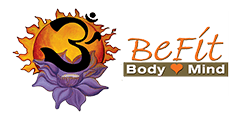Turning our body upside down
This turned into a long topic (over 40 pages of information!) — there is a lot going on with inversions that is beyond just physically doing them (I do cover the physical aspects at the end). I took the time here to share information about why we do invert — and where the benefit is, its not just strength and balance or in the physical, the benefits of inversions greatly influence our hormones and nervous system. I have taken the time to share this information and in the process help you learn more about your hormonal balance and it’s importance.
- We start off learning about the emotional benefit and some esoteric yoga beliefs about inversions — which are later supported when we talk about the pineal gland.
- We cover breathing while inverted
- Then we move into learning about the glands in our head (pineal gland, and endocrine glands; thalamus and hypothalamus, and pituitary, throat (thyroid), and chest (thymus).
- We then review safety and contraindications to inverting, and when to learn inversions, bandhas while inverted, and how long to hold inversions.
- From there we learn the physical side of inversions and use the closing series of Asthanga yoga to learn how to do inversions.
Inversions are potent asanas! Shoulderstand and headstand are known as the Queen and King of yoga poses, their profound nature is due to the dramatic effect on our physiological and psychological bodies.
Physiologically inverted asanas affect blood flow, hormones and endocrine function, muscle tone, waste removal, organ function, and breathing patterns. Inversions are a big topic as they directly influence all the major glands of our endocrine system ~ which is a big system! Throughout learning about inversions you are also going to learn about your thalamus, hypothalamus, pituitary, pineal, thymus, and thyroid glands …
A quick addition; I was listening to a podcast with Dale Bredesen, MD, with his research group, he’s published over 220 scientific papers leading to the first description of the reversal of cognitive decline in patients with Alzheimer’s disease. His book, The End of Alzheimer’s, outlines the lifestyle program that is the first program to not only stop Alzeimer’s but reverse it! He’s discovered the importance of blood flow to the brain, I’ve quoted him below:
“There’s a lot that you can do. Exercise is critical. You want both some strength training because that improves your insulin sensitivity and you want to have some aerobics. Both of those improves oxygenation. Blood flow to your brain turns out to be more important than we ever were told in the past.”
One of the main reasons we invert in yoga is to get blood flow to the brain which is also why we don’t want weight on our head while in headstand. Once again modern science proving ancient yogi wisdom.
Psychologically inversions turn our world upside down, giving us a new perspective in life. When we get comfortable being upside down, it is not such a drama when our lives get overturned; we are better able to function and move forward in any situation. This in turn increases our self confidence — another side benefit to inverting your body. Inversions also increase mental power and concentration due to improved blood flow to the brain while inverted.
Inversions are about blood flow to our brain, now is time to learn about what’s above all our asana practice. We are moving out of the body and into the head ~ briefly ~ since one of the ways I used to love to start my yoga classes is by saying “Time to get out of your head and into your body”. And this is still more true! There are times we need to get into our head to learn about it.
We already started that over the past few months as I have been talking about minding your mindstuff and the follow up, and brainwaves. They are all intertwined with this topic as well.
The Esoteric Yoga View of Inversions and Amrita Bindu
The fountain of youth (the esoteric side of inversions)
In Yoga philosophy we have a “nectar of life” called Amrita bindu that we store in our crown chakra.
- It is written that after taking food, the blood absorbs the nutrients from the foods we eat and after 32 days 1 drop of new blood is made.
- It takes 32 drops of this new blood to make one single drop of Amrita bindu (vital life nectar).
- The math … it takes just under three years to make one drop.
- This amritabindhu is stored in the Sahasrara (crown) chakra.
- Our amrita bindhu can be depleted by living badly, eating badly, and thinking negative thoughts—it begins to travel downwards and is consumed by the upward flow of agni (our digestive fire) at the third chakra. When amrita bindhu is lost, life itself has lost its luster.
The practice of inverted asana (particularly sarvangasana (shoulderstand) and sirsasana (headstand) are the method by the yogis for storing our amrita bindhu. When we are inverted our amrita bindhu remains safely in Sahasrara chakra, its downward flow is prevented—keeping us youthful. The agni (digestive fire) always travels in an upward direction, when we are inverted, it still travels upward turning it towards the anus, cleansing and purifying the organs of digestion and elimination.
If mula bandha is strong and the digestive fire can travel all the way to the “mula” or root of our spine—the Muladhara chakra (root chakra) it will stimulate the release of Traya Granthis (knots that block our energy flow) and begin the gradual process of awakening our Kundalini energy. (Excerpts from Astanga Yoga by Lino Miele)
What is Raising your Kundalini.
Amrita bindu is the fountain of youth, it takes just under three years to make one drop of this nectar—so to stay youthful— eat good food, think good thoughts, and hang out in headstand 😉
Inverted asanas are first and foremost about blood flow!
Stale blood and lymph stagnates on the lower areas of our organs, unless we get our heart rate up to a high rate, blood circulates only through the upper areas of our organs, leaving stale blood to accumulate in the lower regions of the organs. In this stale blood is where disease begins. When we invert this stale blood and lymph is drained from the organs, put back into the circulatory system where the blood is cleaned and oxygenated taking fresh nutrients and oxygen to the cells in our organs.
In yoga philosophy this it is said inversions purify our blood. Also, the reverse action of gravity on the body encourages a rich supply of blood flow to the brain and eyes nourishing the neurons and flushing out toxins. This is believed to enhance our concentration and mental capacity, and balance the functions of the thalamus, hypothalamus, and pituitary glands. Enriched blood flow is also directed toward the throat where we house our thyroid and thymus glands, those are brought into balance particularly by the practice of shoulderstand balancing our entire endocrine system between the head and neck.
Breathing while inverted
Inversions and half inversions such as down dog and standing forward bends aid the exhale, the weight of the abdominal organs against the underside of the diaphragm causes you to exhale more completely and correctly, maximizing the exchange of carbon dioxide and oxygen. This is even more pronounced in full inversions—gravity is pushing the abdominal organs onto the diaphragm lengthening the muscular fibers nearly to their maximum giving us a deep exhale and a deeper “detoxing” of carbon dioxide which makes space for more oxygen to come in on the next inhale giving us a deep and satisfying inhale.
Inversions actually prevent chest and backward breathing; the muscles that are responsible to breathe incorrectly are busy supporting the inversion, And therefore unable to help breathe incorrectly!
Also while inverted the inhale will be working the diaphragm harder to push the organs inferiorly (toward the ceiling) as it draws air into the lungs; this strengthens the diaphragm. Even people with the worst breathing habits in upright postures will have better breathing habits while inverted.
The brain and detoxification
Glymphatics and sleep and cerebral spinal fluid.
Our Brains have an Immune System! And it’s quite “malleable” . . .
The link between toxins, our immune response, and the brain is not completely clear, but it is receiving some attention lately. In a report titled “Structural and functional features of central nervous system lymphatic vessels”, by Louvea et al made an 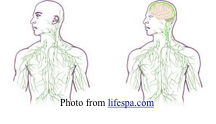 announcement about basic anatomy we should have known by now . . . The brain has a lymphatic system — given the term glymphatic system. This glymphatic system connects to our immune system — the lymphatic system of our bodies.
announcement about basic anatomy we should have known by now . . . The brain has a lymphatic system — given the term glymphatic system. This glymphatic system connects to our immune system — the lymphatic system of our bodies.
It used to be believed the brain was “privileged” and somehow toxins did not effect it so much. We now know toxins in our environment effect our brain at a much greater rate than we realized previously. We thought that chemicals were only dangerous in big doses . . . Even small doses of chemicals, which can synergize together to wreak havoc in dose ranges as low as parts-per-billion ranges. We still don’t consider many chemicals we are exposed to on a daily bases a toxic burden on our body that is leading to many diseases. Toxins not only effect our brain more than we realized, they also greatly effect our endocrine system — our hormones. This is one of the causes of the increase in auto-immune diseases we are seeing.
Glymphatic sluggishness or malfunction has been linked to auto-immune concerns, infection, inflammation, and cognitive/memory related issues.
The glymphatic system is active while we sleep, it takes about 6-8 hours for the glymphatics to “do their job”. They are like hidden caves that open up at night while we sleep and drain our brain toxic waste and proteins into our cerebral spinal fluid where they can be detoxified. In fact the most talked about brain toxin (neurotoxin), beta amyloid plaque is drained while we sleep through these glymphatics. We do most of our brain detoxing while we sleep, hence the importance of sleep on our cognitive function. The glympahtics clears about 3# of toxins each year from our brain.
Researchers found sleeping on your side helps to drain the glymphatics better.
ref. Dr. Douillard lifespa.com https://lifespa.com/lymphatic-system-ayurveda/
The authors of the lymphatics paper state:
“The discovery of the central nervous system lymphatic system may call for a reassessment of basic assumptions in neuroimmunology and sheds new light on the aetiology of neuroinflammatory and neurodegenerative diseases associated with immune system dysfunction.”
What this means? Our brains lymphatics system, aka the glymphatic system, drains into the lymphatic system in our bodies through the cerebral spinal fluid. If we have a sluggish lymphatic system (this is common) it will effect the brains ability to detoxify into the lymph system of the body causing toxins to remain in the brain.
Want to take care of your lymphatic system now? Movement is important! As is the Ayurvedic oil massage known as abhyanga which I recommend be done daily. Sipping warm water throughout your day helps your immune system, citrus fruits, and massages are all good support for your lymphatics and glymphatics. And possibly inversion too! Inverting may help your entire lymphatic system circulate.
And while we are on the topic of the brain and new evidence . . . there is more evidence that your brain is malleable and changes continually in response to your lifestyle. This concept is called neuroplasticity (Neuroplasticity is the ability of your brain to change and adapt in response to our experiences.)
It used to be thought that your brains was static except during young critical development stages. Remember in the old days, being told you can not make new neurons?
We now know this is not true. Your brain has the remarkable ability to re-organize pathways, create new connections and new neurons throughout our lifetime — Functional plasticity is your brain’s ability to move functions from one damaged area of the brain to another undamaged area — structural plasticicty is the ability of your brain to change shape as you learn something new.
The point is we have much more control over our body, mind, and brain than we realized.
It used to be thought the human brain could not generate new neural cells, cells would die and no new cells could generate leaving us dumber and dumber . . . guess what?! It has been proven that certain areas of your brain can regenerate new cells — called neurogenesis — and create new neural pathways.
Environment plays an essential role in these processes. This applies to emotional states as well; if you have a history of anxiety, your brain becomes wired for anxiety. If you develop tools to feel calm (yoga:) more of the time, those anxiety pathways are pruned away. Use it or lose it has a good connotation here!
Your brain is influenced by lifestyle, diet, exercise, attitude and emotions, sleep patterns, your level of stress, and how you think …
Sleep
Sleep is an important part of our health. Consistently getting less than six hours sleep per night sets us up for a series of ailments.
Number one your brain shrinks! This sets you up for a higher risk of dementia and Alzheimer’s as you age. While we sleep our brain detoxes. When we get less that six hour sleep per night our brain is not able to completely detoxify.
Number two when you have inadequate sleep your head is foggy and you can not think as well resulting in a more challenging time making decisions.
Number three lack of sleep messes with our blood sugar and sets one up for diabetes. You crave more food when you have less sleep. There are scientific explanations as to why this happens. Personally I feel it is your body looking for energy wherever it can get it!
Most research shows most people thrive with 7-9 hours of sleep per night. It is important to plan your life around this sleep time. Getting up at 4am do to your yoga practice is only beneficial if you have adequate sleep first, otherwise you are better off sleeping.
Having a night of bad sleep here or there is part of life and won’t wreck your health, it is when sleep is consistently deprived that it becomes problematic. If you do get a short nights sleep or have problems falling asleep naps are good! A 20-30 minute nap in the afternoon can help recharge your batteries for the remainder of the day. And for those who struggle with falling asleep naps help your body practice falling asleep, so hopefully it becomes easier to do so at bedtime.
Also it has been helpful for me to turn off all normal lights by 9pm and use only orange light bulbs or candle light, or a salt lamp. Orange light or firelight does not interfere with your melatonin production, melatonin is secreted by your pineal gland which is connected to your eyes and senses light. In the evening as the sun sets and light fades, cortisol production drops (cortisol wakes us up!) as your melatonin increases. This helps to prepare your body for sleep.
The “yogi” gland … Pineal Gland
The pineal gland connects the endocrine system with the nervous system, it converts nerve signals from the sympathetic system into hormone signals, it is made of both — cells from the nervous system called neuroglial cells and pineal cells called pinealocytes.
This starts the first of the many glands that connect various systems of our body into a coherence of communication. The communication between the body systems is important to stay in health balance.
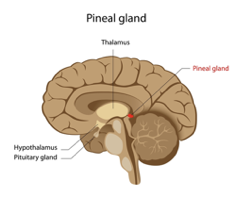
The pineal gland is a tiny little gland deep in the center of your head — seated behind the thalamus, hypothalamus, and pituitary gland. These are the glands that
inversions nourish with blood flow. Maybe even similar to how organs in our body get the wringing out and re-soaking effect during asana.
The pineal gland is able to deliver its hormones across the blood-brain barrier (bbb). The blood-brain barrier is a protective mechanism of the body, if you inject dye into your blood stream the tissues of your body turn blue — EXCEPT your brain and spinal cord. Thus the body protects the brain and spinal cord from many substances. The pineal gland is one of the glands that can pass through this barrier making it able to deliver its hormones into the brain, because of it’s benefit to brain health. The pineal gland has profuse blood flow second only to the kidneys. To date, I have not been able to find in the research why the pineal gland has such a profuse blood flow.
Yogis and the pineal third eye
Let’s learn about our pineal gland and then some interesting ways yoga effects it:
The hormone the pineal gland creates is melatonin. Melatonin is what helps us sleep at night. In the dark our body releases melatonin and we feel sleepy; in the light our body does not make melatonin.
The pineal gland and melatonin, it seems may be connected to the Amrita bindhu or nectar of life I was talking about. Some ayurvedic doctors and yoga science researchers have stated melatonin is the Amrita Bindhu or nectar of life.
The area the pineal gland is in is represented by the “cobra snake eyes” symbol that is often associated with the 6th chakra, which is also the chakra that is closest 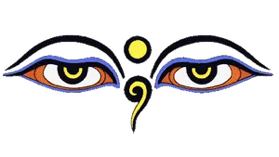 aligned to our pineal gland. This is the area of our “third eye” or the eye of clairvoyance — or “clear vision” — that ability to sense something about a person, object, situation, or location through an extrasensory perception — or our 6th sense … which oddly corresponds with the 6th chakra.
aligned to our pineal gland. This is the area of our “third eye” or the eye of clairvoyance — or “clear vision” — that ability to sense something about a person, object, situation, or location through an extrasensory perception — or our 6th sense … which oddly corresponds with the 6th chakra.
Descartes spoke about your pineal gland and the third eye:
Descartes identified the pineal gland as the “seat of the soul,” and there is a rich, venerated history in Eastern and Western mystical/spiritual doctrines of the pineal gland as a source for mystical experiences.
The pineal gland has been described historically as the “third eye.” This may be due to the fact that the pineal gland is a source of dimethyltryptamine (DMT), which is commonly associated with visionary or mystical experiences — ayahuasca is a source of DMT.
My guess would be that meditation helps us develop this 6th sense, whether inversions do or not, I don’t know and don’t want to try to find any “research” on it at the moment … However the fact that the pineal gland is the 2nd area in the body with the most profuse blood flow — and inversions are about blood flow to the head, my educated guess would be that yes, inversions enhance our pineal gland but I feel meditation is more effective to develop the extrasensory perceptions.
Also related to a 6th sense, is our sense of navigation.
Studies done mostly with birds strongly suggest that the pineal gland is a center for navigation — another form of a 6th sense. Scientists believe that the pineal body is a magnetoreceptor, capable of monitoring magnetic fields, and helping to align the body in space. Changing the direction of magnetic fields around the heads of birds alters their ability to orient. Electromagnetic fields (EMF) suppress the activity of the pineal gland and reduce melatonin production. EMF activity therefore has potential to disrupt the bodies circadian rhythms. Just one reason why I recommend you turn off your Wi-Fi at night and try to sleep in an EMF free zone.
Also perhaps relevant is that the cells of the pineal gland, called pinealocytes, have characteristics that are strikingly similar to photoreceptor cells in the human retina — another nod to “clear seeing”.
Source: www.commons.wikimedia.org and http://www.ncbi.nlm.nih.gov/pmc/articles/PMC3001216/
The pineal gland and its “medicine”, melatonin.
Melatonin is sometimes called the “Dracula of hormones” – it only comes out in the dark. Even if the pineal gland is switched “on” by the clock, it will not produce melatonin unless the person is in a dimly lit environment. In addition to sunlight, artificial indoor lighting can be bright enough to prevent the release of melatonin. Sleep is very important to our health, to sleep better keep your room very dark at night.
Melatonin and “science”
Melatonin slows the aging process (a defense against free radicals), prevents jet lag, is implicated in seasonal affective disorder, allows for deep restful sleep patterns, and it even coordinates fertility — it is connected with our reproduction hormones — The pineal gland works as a switch-off button for all the hormones while the pituitary on the other hand functions as an on-switch for the hormones. This parallels the yoga teachings on the ajna (6th) chakra as the commanding chakra. The amount of substances released by the pineal gland is determined by light and stress.
Melatonin has been shown to inhibit the growth and metastasis of some tumors in experimental animals, and may therefore play a role in cancer inhibition. Removal of the pineal gland and/or reduction in melatonin output have been implicated in the increased incidence of breast cancer in laboratory animals. Patients who have breast cancer have lower levels of melatonin in the blood. The hormone has also been shown to be protective against genetic damage, and it has a stimulatory effect on the immune system.
Speaking of our immune system, while I usually write these topics to be mostly evergreen, as I write this we are in the middle of the Covid19 pandemic, and melatonin has an important role to play in our inflammatory response and immune responses which greatly increases the likelihood of survival rates in the disease.
Several studies have shown that melatonin reduces chronic and acute inflammation. The immunomodulatory properties of melatonin are well known; it acts on the immune system by regulating cytokine production of immune cells. Experimental and clinical data showing that melatonin reduces adhesion molecules and pro-inflammatory cytokines.
This is important in a coronavirus epidemic, while the virus itself may not kill you, the cytokine storm it creates in your lungs, does. This cytokine storm is what melatonin prevents. When your body’s immune system sends inflammatory molecules – it is sending those for healing the area. However there is collateral damage from a healthy inflammatory response.
I am going to use the wart remedy Compound W as an example here (but want to add I am not recommending it for warts! Apple Cider Vinegar with our without essential oils is more effective without the collateral damage of Compound W).
If you ever used Compound W on a wart, in many cases it did help effectively to eradicate the wart, however if you remember the skin around your wart got damaged as well in the process. Well this is similar to what happens in the body with the inflammatory response.
In an ideal response, we want the inflammatory molecules to come do their healing while leaving as little damage in their wake as possible. This is where melatonin (and anti-inflammatory foods, oils, and essential oils) come into play. These natural substances reduce the collateral damage our immune response creates.
As a consequence, melatonin improves the clinical course of illnesses which have an inflammatory responses — including Covid19.
Also recently discovered as coronaviruses receive a lot of research attention — and important to know it’s effect on our melatonin:
The herbicide/pesticide roundup aka glyphosate reduces your body’s ability to make melatonin. One of the ways roundup kills pests and weeds is by destroying their digestive tracts, known as the shikimate pathway. Coincidentally this is why it was initially touted as safe for humans since we don’t have a shikimate pathway — however, OUR GUT BUGS DO HAVE A SHIKIMATE PATHWAY as do plants, and this is one of the ways roundup ruins our guts. Those gut bugs do some important heavy lifting for our bodies.
Our body makes melatonin from serotonin, which in turn is derived from tryptophan, one of the three amino acids that are part of the shikimate pathway of which roundup decimates in plants and our guts. Our gut bacteria produce tryptophan for us in their shikimate pathways so roundup certainly has the potential reduce the bioavailability of tryptophan as a precursor to melatonin.
Furthermore melatonin also helps reduce our risk of sepsis — another fatal side effect of Covid19 infection. Melatonin is an excellent antiseptic and antibacterial and can help us effectively mitigate these scary side effects of a covid19 infection.
Here is a 2019 pubmed study on this.
I don’t have access to all the journals listing this research but Dr. Mercola reported about it here.
Evidence supports its actions as a direct and indirect antioxidant, scavenging free radicals, stimulating antioxidant enzymes, enhancing the activities of other antioxidants or protecting other antioxidant enzymes from oxidative damage. Several encouraging clinical studies suggest that melatonin is a neuroprotective molecule in neurodegenerative disorders where brain oxidative damage has been implicated.
In lieu of our current situation, I have gotten several questions or melatonin supplementation. While I am always conscious of supplements, and especially supplements that mess with our hormones there is a new melatonin liquid supplement on the market that I like. Most melatonin supplements have too high of a dosage and causes a flushing and uncomfortable side effect. Liquid melatonin is able to be micordosed — you can start with as little as one drop and experiment each night by increasing by one drop until you feel it is effective for you without side effects. lifespa.com has is a good resource for liquid melatonin.
And lastly melatonin production does tend to show declines as people age, is this due to our lifestyles? Perhaps, we have had many years of abusing our melatonin since the introduction of indoor lighting!
Melatonin production is not confined exclusively to the pineal gland, but other tissues including the retina, glands in our eyes (Harderian glands), our gut, our ovary / testes, and bone marrow all can produce melatonin, one of the signs the body wants to make sure you have melatonin.
Don’t mess with your melatonin!
Foods that specifically support and activate the gland are cacao beans, turmeric, green plants and vegetables, grass juices, wild harvested spring water, reishi mushroom tea, beets, apple cider vinegar, and others. And we also have a lot of foods that have melatonin (or tryptophan which is needed to make melatonin in our body) in.
Anxiety is linked to low melatonin production, strategies to keep your melatonin levels in balance may be useful for people who feel anxiety. Treatments including lifestyle change as well as a diet rich in tryptophan (amino acid needed for the production of melatonin) is utilized in many alternative treatments for anxious people.
Foods to support melatonin production, first, foods rich in tryptophan are:
- Chicken
- Turkey
- Almond
- Sweetcorn
- Peanuts
Other foods high in melatonin (and support good sleep) include:
- Tart Cherries (sweet cherries have some, but much less)
- Almonds
- Raspberries
- Goji berries (I think these are the highest)
- Orange bell peppers
- Walnuts
- flaxseeds
- tomatoes
- Fenugreek
- Mustard seeds
Cortisol and melatonin work together in a rhythm.
We need cortisol in the morning to wake up, throughout our day our cortisol levels drop eventually preparing us for sleep at night. As we sleep our cortisol levels slowly rise to wake us up in the morning ….
When cortisol peaks, melatonin plummets. When melatonin is down, cortisol is up. That’s normal.
Stress will interfere with this rhythm and make it hard for you to fall asleep at night — remember what two factors influence your production of melatonin — Light and Stress. Marinate in stress hormones all day and you disrupt this natural rhythm — and disrupt your immune response as well.
Melatonin primes your immune function and thus stimulates healing inflammation, while cortisol tends to dampen immunity and reduce the healing side of inflammation.
Is your pineal gland calcified?
The pineal gland is subject to calcification; Calcium, phosphorus, and fluoride deposits in the pineal gland have been correlated with aging. Recent studies show that the degree of pineal gland calcification is significantly higher in Alzheimer’s disease patients, and is correlated to impaired cognition at all levels. This is exacerbated by Vitamin K2 deficiency.
Calcification of your pineal gland will also disturb your circadian rhythm since it will interfere with melatonin production. When your pineal gland is calcified your melatonin production is reduced therefore disrupting your circadian rhythm cortisol levels. We are seeing calcification of the pineal gland more and more, and now in children too!. Fluoride and calcium supplements are the major cause of calcification of your pineal gland. Calcification of the pineal gland is connected to all forms of dementia.
It’s unknown what effect pineal calcification might have on attaining states of higher consciousness, but I’d rather not find out the hard way.
To avoid calcification of your pineal gland or help reverse it if it’s already started:
- Vitamin D (sunshine!)
- Vitamin K2 (fermented foods and bone broth) and liver are helpful.
- Take Epsom salts baths (magnesium is essential in calcium metabolism)
Avoid sources of fluoride and supplemented calcium.
Ref:”rethinking fatigue, what your adrenals are really telling you and what you Can do about it” by Nora Gedgaudas
Our Endocrine System and our Brain
There are major glands in our brain that are part of our endocrine system — the pituitary gland, thalamus, hypothalamus, and pineal glands are all in our brain. Hence our brain function will impact our hormone function and vice versa! And remember, if your hormone function is out of balance, you suffer.
The nervous and endocrine systems are deeply linked throughout our entire body, in fact nerves in the pelvic floor are related to functions from the endocrine glands in the brain. When I was researching about mula bandha, the yoga science kept touting its benefits to your hormonal system, yet I could not find the link … until now that is, your mula bandha directly effects your nervous system balance, and these glands (specifically the hypothalamus) connects your nervous system to you hormonal system.
The text ‘Mula Bandha’ by Bihar School of Yoga states; “The physical contraction of perineum has beneficial effects of maintaining hormonal balance and stimulating and regulating the nerves that innervate the lower pelvic region. Many of the nerves that regulate the pineal and pituitary glands in the brain are in the pelvic region -– the toning of your mula bandha positively affects those nerves.” Along with inversions to enrich these glands with blood flow, remember your mula bandha!
Hormones are a big subject — as are these glands in the brain! They regulate a lot of processes in our body.
Hormonal is from the greek word “to set in motion”, hormone on the other hand means to “send out a message” — from one cell to another. These messages impact our physical and emotional well being; hormones control our anger, how well we sleep, when we feel like laughing, when we feel like crying . . . when we feel like having sex, when to eat, and when to fall asleep. Hormones impact virtually every major system and organ in our body. When they are out of balance you suffer. . .
Thalamus / Hypothalamus
Our Thalamus and Hypothalamus are also located in the brain.
An important function of yoga is the cortical balance with thalamus function of our brain. Cortical balance is referring to our thinking function of our brain. Our thalamus is what sets our perceptions (and this is tied in with our drishti, which literally means ‘to perceive’ or perception). Our moods reflect our cortical balance. Real yoga teaches us how to manage our emotions and like more people!
Our thalamus effects how our brain perceives — the thalamus receives signals from our senses sight, sound, taste, and feel (all except our nose/smell) then sends these sensations to our cerebral cortex for interpretation. But it is the thalamus that is most responsible for our perception not the cerebral cortex. The thalamus acts as a gate filtering which information from various channels (eyes, ears, touch, taste) is allowed to be relayed to the cerebral cortex for processing. Our thalamus sets our perception.
The thalamus has connections with the cerebral cortex and together they set our consciousness.
Damage to your thalamus leaves you in a coma. It has also been found that people with schizophrenia have decreased connectivity between their thalamus and the prefrontal cortex. We want to keep our thalamus healthy and connected to or communicating with our cortex to stay sane.
https://www.nih.gov/news-events/nih-research-matters/new-role-discovered-thalamus
So how do we keep our thalamus healthy and connected? Meditation and pranayama breathing exercises are the best ways to keep your thalamus healthy 🙂 While inversions do bring blood flow, in reality it seems meditation and breathing effectively balances the thalamus function by bringing the four lobes of our brain into coherence, therefore helping the different areas of our brain communicate and synchronize their activities.
The Gamma brain waives modulate our perception and consciousness, which are similar functions to the thalamus so it seems to me there is a connection between the thalamus and gamma brain waves.
By encouraging gamma brain waves (breathing exercises are helpful) we get better communication between our thalamus and cortex. When we have better connections we have better integration of our life’s experiences because we perceived them as food for growth.
While inversions may not increase gamma brain waves (and maybe they do!) inversions themself will improve blood flow balancing these glands.
So your Thalamus receives signals from your senses and filters them, then sends information to the brain, meanwhile your hypothalamus is collecting information and data from your nervous system …
What does the hypothalamus do?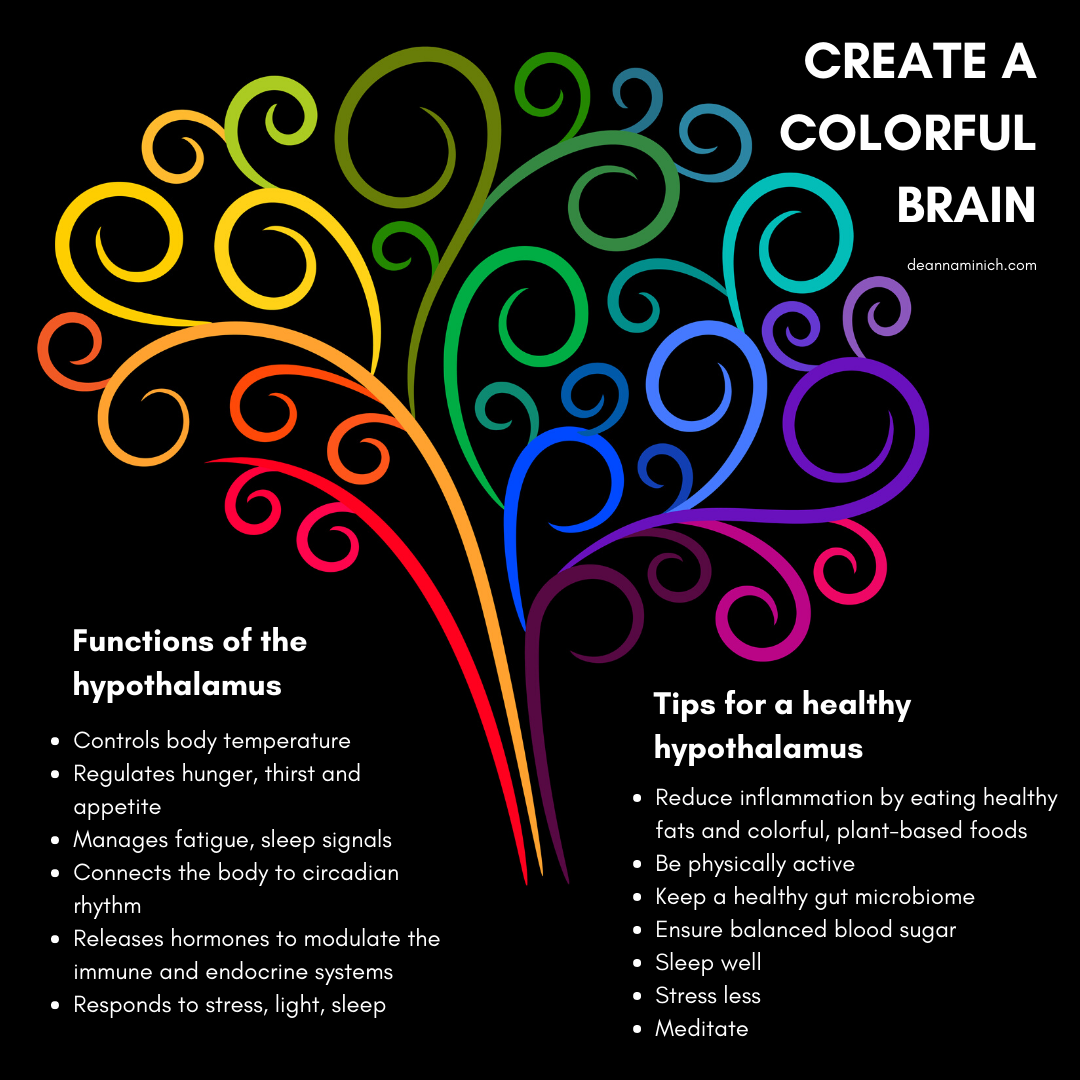
The hypothalamus is a control center for many of the functions of our autonomic nervous system — which we talk about a lot in yoga. Our hypothalamus helps us maintain homeostasis where our body can rejuvenate by resetting our stress response back to being parasympathetic dominant.
The hypothalamus is closely related to the thalamus and pituitary glands — the location of all these glands is in close proximity to each other. The thalamus gland acts as bridge between all these glands — and these three glands together (along with the pineal gland) all bring together and balance the nervous and endocrine systems. When these systems are in balance we are happy well adjusted human beings!
Your hypothalamus receives signals from your nervous system (the neurons themselves) — hence it regulates our stress response. It then responds by sending signals to the adrenals and pituitary glands to release stress hormones or to inhibit stress hormones.
- The hypothalamus also sends out our hunger signals.
- Our hypothalamus also helps to maintains our body temperature, it it receives a signal that our internal temperature is too high it makes our body sweat, it it receives the signal you’re cold, it makes you shiver.
Your hypothalamus is actually part of your limbic system (where our need to survive is housed) and as such will effect your moods and stress levels. The hypothalamus is a region of the brain that effects thirst, hunger, body temperature, emotions, and even sleep; it:
- Responds to stress by diverting digestive and rebuilding hormones to allow for a stress hormone response. This is the response that can become destructive if you are constantly under stress.
- It creates somatostatin which inhibits the release of TSH (thyroid stimulating hormone) and GH (Growth hormone) and in conjunction with your pancreas which also releases somatostatin in response to stress to stop the digestive process and deal with the stress at hand.
- And when the stress is over it can also stimulate the release of both TSH and GH for growth and repair of tissues, while the pancreas will then also stop secreting somatostatin so it can go back to digesting.
As such, since the hypothalamus essentially puts you in a stress response or not — it will effect all these processes in the body:
- Regulates blood pressure, heart rate, satiety, thermoregulation and sleep/wake cycles
- It is also involved with memory and learning, arousal, pupil dilation, and shivering …
- Tells your pituitary gland to release stress hormones in response to stress
- Oxytocin, it tells our pituitary to release oxytocin – that’s our love hormone 🙂
- Releases a hormone (gonadotropin releasing hormone) that stimulations the pituitary to release reproductive hormones
In an essence your hypothalamus tells your pituitary gland when to release its hormones. If your hormones are already out of balance the hypothalamus may not stimulate the pituitary gland to release more hormones; this is called a negative feedback loop, it is normally a healthy loop but if your hormones get out of balance it could further cause imbalance.
In recent research, functioning of our hypothalamus gland is directly linked to our aging process, which makes sense as the hypothalamus controls our stress response and stress hormones make us age prematurely. Our hormone balance will age us or keep us young.
How to keep your hypothalamus balanced — Eat your vegetables, fruits, and clean fats and proteins. And of course … sleep and exercise/yoga. In addition;
- Green tea – Studies show the antioxidants in green tea protect your hypothalamus from bad fats by reducing inflammatory molecules.
- Purple foods are brain foods; blueberries, purple cabbage, purple rice,
- Omega3 fatty acids for overall brain health and anti-inflammation, and Vitamins B and C
- Chromium has been shown to help keep our hypothalamus young and healthy. https://www.ncbi.nlm.nih.gov/pubmed/7838011
- Best foods for chromium? Broccoli, garlic, basil, potatoes, green beans, oranges, apples, bananas, healthy fats, and grass fed meats.
- Frankincense and Myrrh – Two of the primary active compounds in these oils; monoterpenes and sesquiterpenes increase oxygen around the receptor sights of the hypothalamus, pineal, and pituitary glands. And both compounds are highly anti-inflammatory and anti-oxidant. Sesquiterpenes also have a calming effect on the emotional center of our hypothalamus.
- Ways to use them? diffuse, personal inhaler, whiff from the bottle, or make a body oil with them. They both are lovely for skin. For more information and ideas how to do this, contact Bobbi.
- And for women if you feel your hormones are out of balance check with your doctor about trying the herb vitex.
Pituitary Gland
The pituitary gland secretes and stores hormones, which it uses to stimulate your other glands. It specifically has a strong effect on the thyroid and is closely related to thyroid health. TSH is the thyroid hormone released by the pituitary — if your pituitary is overworked (perhaps by an imbalance in other hormones — ex. stress hormones), it won’t be able to release enough TSH to signal your thyroid to produce thyroid hormones.
Specifically, your pituitary gland manufactures eight different types of hormones: thyroid stimulating hormone (TSH), luteinising hormone (LH), follicle stimulating hormone (FSH), prolactin, growth hormone, adrenocorticotropic hormone (ACTH), antidiuretic hormone (ADH), and oxytocin.
What disrupts your pituitary gland? Sugar and stress are pretty much the root cause of many imbalances including hormonal imbalances.
- Blood sugar issues of all types; insulin resistance to hypoglycemia
- Stress that results in elevated cortisol levels
- Pregnancy
How to keep your pituitary gland healthy? Eat a balanced vegetable rich diet with a good source of protein and avoid sugar …. In addition;
- Vitamin D is important for its function, maintaining vitamin D levels, especially through the winter will help keep your hormones in balance.
- Antioxidant rich foods, especially Vitamin E rich foods such as almonds and seeds, and their oils.
- Vitamin A and Iodine balances both the pituitary and thyroid glands. Good food sources include orange foods
- Manganese helps to regulate blood sugar, metabolize carbohydrates, and absorb calcium. It is available in whole grains, legumes, and nuts.
- Milk Thistle and cabbage foods can help keep your pituitary and hormones balanced as well as help your liver detox — which is important in hormonal balance. After you use a hormone it has be excreted, your liver is the organ that breaks down used hormones and removes them, foods that help the liver detox will also help to balance hormones.
- Beet juice (beet kvass is also great for this), chlorella and other algae, and cod liver oil (yuck) helps to flush out calcium and fluoride from our brain which clog up our brain like plaque does to arteries.
Eat your oregano … It is powerful anti-microbial and anti-oxidant. It helps to remove harmful organisms that like to attack our pituitary gland.
Your Thyroid
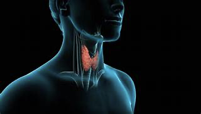 I view your thyroid as a gatekeeper of types, or maybe our thyroid is our internal “canary in the coal mine”. When our body is burdened by toxins or stress or reactive foods your thyroid balance is one of the first things to go. Your thyroid is a butterfly shape that wraps around your trachea windpipe and is in close contact with every thing you eat, breathe, and say.
I view your thyroid as a gatekeeper of types, or maybe our thyroid is our internal “canary in the coal mine”. When our body is burdened by toxins or stress or reactive foods your thyroid balance is one of the first things to go. Your thyroid is a butterfly shape that wraps around your trachea windpipe and is in close contact with every thing you eat, breathe, and say.
Your thyroid is what fuels your day — its your get up and go energy; from getting out of bed, to walking up steps or just moving around, to how well your perform in your workday, to how you feel and relax or cook in the evening hours.
Your thyroid is also what gives you energy to concentrate. If you are feeling listless, bored, or detached … like you just don’t really care as you watch your life in front of you instead of living it … then you might be dealing with thyroid issues. If your libido is low, look to your thyroid.
Your thyroid is also in contact with your immune system, if you are getting sick, frequently getting whatever comes down the road your way, this is a sign you have poorly functioning thyroid. 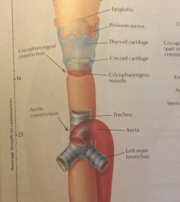
And to top it all off, if you are experiencing digestive issues your thyroid could be at the root as it can be a root cause of leaky gut.
When your thyroid is functioning poorly your whole body suffers. Poorly functioning thyroid can also lead to heart disease, it can also increase your risk for developing cancer — specifically breast cancer. It can set you up for dementia and a poorly functioning thyroid can be the root cause of depression and cognitive decline along with many other types of psychiatric disorders.
Before doom and gloom ~ before any of these orders develop~ you will have signs … you could feel:
- wired or exhausted,
- foggy or hyper,
- really you just don’t feel like yourself.
- You can’t seem to lose weight — or maybe you can’t seem to gain weight.
- You just don’t know where your energy went
- and you can’t understand why your brain is not working right.
A poorly functioning thyroid makes life miserable.
Your thyroid secretes hormones that help to regulate your cells and some of your organs. The thyroid signaling system is very complex — and this is why it is so misunderstood. It puts AI (automated intelligence) to shame.
The thyroid signaling system coordinates messages between your hypothalamus, pituitary, thalamus glands, and your liver, blood, and cells — it is just trying to get the right amount of hormones to each cell, and that itself is a balancing act that is different from day to day. This is many times why supplemented hormones cause issues because they can’t fluctuate with your day. The body has a level of intelligence way above that of a supplement.
Thyroid hormones include:
- T3 – The active form
- T4 – the less active form which needs to be converted to T3
- TBG – thyroid binding globulin, which binds T3, making it inactive, and carries it through your bloodstream
- TSH—thyroid stimulating hormone, which tells your thyroid gland to make more T3/T4
- Reverse T3—an inactive hormone — if you have too much T3 — or if your signaling system thinks you have too much T3 your liver will convert T4 to reverse T3. (Your liver also switches to Reverse T3 production when it believes your body needs to conserve energy, fore example if there is a food shortage or you are in a high stress situation.)
Here is a little insight into the string of command:
- Hypothalamus secretes TRH ▼ (Thyrotropin-releasing hormone – it’s a master regulator of thyroid function controlling metabolic rate, heat generation, neuromuscular function, heart rate and other functions.)
- Pituitary secretes TSH which stimulates your thyroid to secrete T4/T3 (thyroid stimulating hormones)▼ (As we have seen, TSH is a hormone released by the pituitary gland. If your pituitary is overworked (say from stress), it might not be able to release enough TSH to signal your thyroid to produce thyroid hormone. In this case, your thyroid would be in good shape—but your pituitary isn’t able to send it the right messages.
- Thyroid secretes T4 and some T3 ▼
- Liver and cells convert T4 to T3 ▼
- T3 enters your cells driving energy production
Thyroid issues can be from an imbalance in one of these hormones or in a relationship between how the different glands function together — but most thyroid issues tend to be related to something outside of us that is an issue, specifically stress, problematic foods, and exposure to toxins. While addressing the imbalances in how our glands function and communicate is beyond the scope of this, what is not beyond our scope is looking at how stress, foods, and toxins effect our thyroid.
The main stressors to our thyroid that we can control… well to some degree: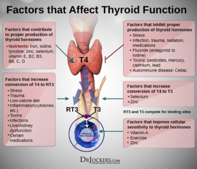
- Stress
- Radiation, thank you TMI and Fukushima
- Fluoride in our drinking water and toiletries
- Bromine, bromide, bromate are all derived from potassium bromate and used in commercial preparations of bread and buns, oh and it’s also used in place of chlorine in some pools and hot tubs … and yea in your food as well …
- Bad dairy and wheat effect the thyroid and end up driving thyroid anti-bodies which leads to hashimotos and destruction of your thyroid
- Pesticides
Your thyroid can disrupt so many functions in the body is can be easier to look at how you feel when your thyroid is working well:
- Easier to maintain your weight
- balanced energy
- memory is good and mental focus is sharp
- healthy glow
Thyroid problems can be hard to diagnose because may of the symptoms resemble other disorders — or you could think you are just stressed or feeling under par. Thyroid imbalances can mimic:
- Chronic Fatigue Syndrome – CFS usually includes swollen lymph nodes and a sore throat. Hypothyroidism especially can be confused with this.
- Lyme Disease – Lyme tends more toward headaches and neurological issues where as thyroid does not.
- Low adrenal function – adrenal exhaustion and slow thyroid tend to go hand in hand.
- Anemia (can be ruled out by a blood test)
- Viral infections (can do a test for white blood cell count)
If you think you have a thyroid issue, what thyroid labs to order? Well I would highly recommend you seek out a Functional Medicine Doctor. Traditional medicine has a very poor track record with thyroid issues because they only test for T3 and TSH, and then just want to put you on thyroid hormones without looking at the balance of all the thyroid hormones.
Here are some of the tests a FMx doc may order:
- Total T3 and/or Free T3 – total amount of T3 hormone in your system, both bound (inactive) and free (active). Free T3 is the amount of free T3. That’s the hormone that actually affects your body, so if these levels are either too low or too high, you are likely to have problems, regardless of what your other numbers say.
- Total T4 and/or Free T4 – likewise total T4 is the total amount of T4 hormone in your body, both bound and free. Free T4 is the amount of free T4 that can either do work or enter cells to be converted to T3.
- Reverse T3
- TSH (thyroid stimulating hormone) – This is technically not a thyroid hormone at all because it’s made by the pituitary. The pituitary monitors blood levels of thyroid hormone. When it perceives that levels are too low, it releases TSH to stimulate your thyroid’s production of more hormone. In this way high levels of TSH correspond to low thyroid output. This is yet another system that works amazingly well—unless something goes wrong.
- Thyroid antibodies – Reactive food and toxins can resemble your thyroid, when your immune system gets overburdened it starts getting “trigger happy” and goes after cells that resemble these toxins and you develop autoimmune disease where your body literally destroys your own thyroid.
- TRH – some doctors find the TRH test is a much better snapshot of what is going on with your thyroid. TRH is Thyrotropin-releasing hormone, the master regulator of thyroid function controlling metabolic rate, heat generation, neuromuscular function, heart rate and other functions.
Your symptoms are more important than your conventional test results. If your physician ignores your symptoms, you are not getting appropriate care.
Find a doctor who will do a comprehensive blood test that looks for as many thyroid markers as possible.
If you suspect Thyroid imbalance, what can you do? #1 manage your STRESS. Those of you here, already have and know tools to handle and mitigate your stress, aside from stress:
- Do a 4 week elimination of gluten and dairy — upon reintroduction, introduce only organic non-dessimated, non-processed gluten and grass fed humanely treated dairy products in small amounts.
- Eat iodine rich foods to protect your thyroid from radiation
- I add a pinch of seaweed to soups, teas, fermented foods, etc.
- Iodine is also pretty high in bone broths, some cheeses, fish, and corn and lima beans.
- Brazil nuts are high in selenium, an essential mineral that is needed for thyroid health.
- Filter your tap water to remove fluoride and make your own toothpaste, or at the very least only by fluoride free toothpaste. Also don’t allow your dentist to do fluoride treatments!
- Avoid conventional breads and buns — you know the fluffy kind.
- Go organic. Organic Organic Organic. Your thyroid does not like pesticides.
The good news? Most people can bring their thyroid back to balance entirely with food and lifestyle — you just need a doctor who is willing to try. One of my favorite FMx doctors who also offers online communities specifically around thyroid and mental disorders is Kelly Brogan, MD. She offers her Vital Life Project and Vital Mind Reset programs to help you make the lifestyle changes with group support. Here is a link for her free resource “Change your food, Heal your mood”.
Your thyroid and your emotions, what do Lise Bourbeau and Louise Hay have to say about thyroid connections and your emotions?
Your thyroid gland links your physical body to your throat chakra or 5th chakra. This is your chakra of will and decision making and thus correlates closely to creating the life you want to live — or the life that brings you meaning and purpose — this is what thrusts you into spiritual and psychological growth. It’s your chakra of decision making. Issues with your thyroid are sometimes stemmed from the feelings you never get to do what you want to do but are always driven to take care of someone or something else.
An overactive thyroid is your body’s way of telling you you are too busy, perhaps you live in constant fear of not being able to act fast enough, or like your hands are tied. Many of your actions can be based on poor judgement or misplaced motivation — others or things out of your control keep pulling you away from the life you want to live, for example someone who requires a lot from you.
If you thyroid is overactive you are receiving the message to slow down a bit, take time to discover your true needs so you can find the life that is meaningful to you. Are you constantly “doing” to validate yourself? If so, it’s time to rethink and rebalance to what is important to you.
An underactive thyroid is a sign you’ve “given up”? Or you are afraid to ask for help? Perhaps feeling stifled? Or insecure? Or feeling you don’t have what it takes to live your dream? Or you are afraid to be yourself? Afraid to speak out? Afraid to say I WANT?
If you were afraid to ask for anything as a child, now’s the time to speak out. As an adult you are able to engineer your own life — and you are allowed to ask for help! It’s time to seek out the life you were born to live.
As you navigate these changes, which can be scary even though exciting to live your dream have faith:
YOU WILL BE GIVEN SOLID GROUND TO STAND ON — OR WINGS TO FLY
That is the lesson of the fifth chakra; faith.
Next time you are in rest pose or meditating; dream the life you want to live. As we slowly start to get our lives back from Covid19, what kind of life do you want? The same? Or something different 🙂 ?
Take a moment now and use the power of your mind to dream your dream life, visualize ~ see yourself living your dream life, what does that look like?
Love your thyroid – Daily thyroid massage
Each morning (and evening) as I do my abhyanga (oil massage) I take a moment and focus on different organs and glands with my mind as I massage that area bringing blood flow and balance to their functions.
When I am doing my face oils, I take a moment and massage my thyroid in a heart shaped movement with both hands.
As an aromatherapist I like to add some oils to balance the thyroid. Myrrh is a feminine balancing oil that is has a history and tradition to be a healer and balancer. If you tend toward sluggish or hypo thyroid function you can include peppermint and lemongrass to help stimulate your thyroid hormones, if you tend toward hyper thyroid then clove and myrrh will help to regulate. A total of 12-15 drops in one ounce of carrier oil will make a nice massage oil for your thyroid.
Your Thymus Gland and your Immunity
 The thymus’ name is derived from the thyme leaf, as its shape is similar. I also read it was derived from the greek word ‘thymos’ which means life energy or soul, and is further explained as the area of the soul where pride, indignation, and shame are stored.
The thymus’ name is derived from the thyme leaf, as its shape is similar. I also read it was derived from the greek word ‘thymos’ which means life energy or soul, and is further explained as the area of the soul where pride, indignation, and shame are stored.
In my aromatherapy and herbal worlds thymos, from which the herb thyme gets its name means “to perfume” — keep in mind in the plant world perfumes are their immune system. The aromatic components we call essential oils are the secondary metabolites that make up the plants immune system. And when we eat the herbs and use the oils we get the plants immune system. So “to perfume” means to provide with immunity.
Interestingly … the herb thyme is a powerful immune booster — it is a potent antiviral, antibacterial, antifungal, antiseptic and an overall anti microbial, anti-parasitic and an immune booster. This is interesting because our thymus is about our immune system and the thyme herb is about protecting our immunity.
The thymus connects the lymphatics (immune) system to our endocrine system, the hypothalamus connects our nervous system to our endocrine system, the thalamus connects our senses to our brain for decision making … and they all work together and to communicate with each other. We are so connected. It is the communications between these glands and organs that is so important for our healthy functions.
The thymus is interesting, it is mostly only active during neonatal phase through puberty. After puberty it slowly shrinks and is replaced by fat, by around 75 years of age your thymus is mostly fatty tissue. However the function of the thymus will protect us throughout our entire life. If you lose your thymus as in infant T cells and lymphoid tissue are depleted resulting in failure of the immune system and a fatal wasting disease. If you lose your thymus as an adult it seems to have little consequence — so we think. There are some theories that this could be a root cause of auto-immune diseases.
The thymus creases thymosin, which stimulates disease fighting T-lymphocyte cells which are white blood cells that protect us from infections and viruses, and cancers, and importantly plays a big role in protecting us against developing auto-immunity. The thymus is the primary support for the lymphatic system.
References:https://www.endocrineweb.com/endocrinology/overview-thymus https://www.ncbi.nlm.nih.gov/pubmed/27627572
How can we keep our thymus healthy as an adult? Support your immune system.
- Herbs such as echinacea which boost your immune function.
- Use thyme in cooking and teas — it is delicious and relaxing in teas. In a nice evening tea, in herbal folklore thyme was woven into mattresses and bedding to protect from viruses and microbes — and it is even said the baby Jesus slept on a bed of hay and thyme. Thyme is also delicious cooking into rice and added to soups and vegetables.
- Cruciferous vegetables which contain glucosinolates which help your body detoxify — especially toxins like heavy metals and cancer cells
- Vitamin C and other anti-oxidants, anti-oxidants actually search the thymus looking for damaging free radicals that can harm your thymus.
- Yoga, exercise, massage and movement due to their effects on your lymphatic circulation.
Thumping your Thymus
The thymus gland is right in between your head and heart — or head and body. Symbolically it represents our ability to love ourselves due to its close real estate position to the heart.
So does the wasting of the thymus gland in adulthood have something to do with the prevalence of auto-immune disease? Perhaps this another area our current knowledge is lacking, perhaps someday we will understand what makes our thymus shrink and by adjusting our lifestyle so it does not shrink we can finally understand how to control, prevent, cure auto-immune diseases.
Until then … Thump your Thymus … when you thump right on your sternum or chest bone, it stimulates your thymus and immune systems. In fact in tapping programs or EFT you thump your thymus to help protect your immunity.
Emotionally if you are having issues with your thymus (auto-immunity) it is a sign you are feeling attacked by life, like they are out to get you.
The thymus being your physical link between your heart chakra and your body; disorders here indicate a block to love of some type, usually it’s an inability to love ourself as an adult or to defend yourself or protect yourself from the barrage of daily life.
Symbolically auto-immune disease represent and inability to love ourselves – or a lack of self love. Remembering to practice self care and self love in our daily routines could be another way to support our immune system and ward off auto-immunity.
The word immunity means sheltered from, or free from ~ Someday soon I hope we can figure out why our thymus gland atrophies in adults resulting in better immunity against auto-immunity. In the words of Lise Bourbeau “When human beings are finally able to love themselves unconditionally, great immunity will emerge at the level of collective humanity. This is the lesson taught by all of the great masters over the centuries.”
Overview on Inversions:
- Due to the location of our endocrine glands in our brain, throat, and chest inversions have a powerful effect on our hormonal system, flushing the glands with blood and nutrients while helping to remove toxins.
- They clean your blood — Circulation. The act of inverting circulates stale blood that sits in the lower portions of our organs and does not circulate. Stale blood is where disease and toxins develop.
- this also improves detoxification
- Breathing upside down strengthens the diaphragm and improves breathing
- Help the body develop awareness
- When we find our balance upside down physically it seems to help us find our balance when life gets topsy turvy emotionally.
- They are empowering
- They add a strength component to our practice
- Inversions have a calming effect on the body, switching us into our parasympathetic nervous system and helping to bring back some homeostasis. According to the Hatha Yoga Pradipika the create peace of mind and alleviate fatigue. I am not sure why the act of inverting would help us switch over to be parasympathetic — my best guess would be because it effects our breathing positively.
- Funny Mind rambling … chickens and inversions — when you put a chicken upside down (or even on it’s back I’m told) it relaxes and lays still. Why? Is possibly the inverting the chicken is putting it in its parasympathetic nervous system? Anyone have any ideas out there?
Are they safe? — they are not for everyone, but they are for many.
There are some concerns and contra-indications around inversions. And this is part of the individualization that is necessary and important in developing your own yoga practice.
When to begin inversions?
In my opinion, it is best to establish a consistent yoga practice before you learn the inversions. For most people about 6 months – 1 year of steady practice will help prepare one to do inversions safely. Also finding the lightness in the practice and having a good understanding of the bandhas will help to protect you while in inverted asanas.
Always start like a beginner … remember its ok to be a beginner! I will share how to start like a beginner in the next couple weeks as we start to look at the physical practice of inversion.
In ashtanga yoga classes there tends to be people with yoga experience from other forms who like to jump into an ashtanga class and do what people do who have been working on it for years — don’t. Be a beginner in ashtanga and learn it slowly. You’ll know it better and know your own body in the inversions better.
And if inversions do not appeal to you, or you just have no desire to turn upside down … That’s ok too! There are a lot of benefits in yoga even if you don’t do inversions.
Contraindications to inversions:
- High blood pressure
- Obesity
- Eye issues
- glaucoma
- detachment of a retina
- If your eyes become repeatedly blood shot after practicing inversions – this could indicate the retinal veins of your eyes are not handling the rush of blood to the eyes.
- Pregnancy
- Menstruation (no practice in general, just rest). Downward facing dog and standing forward bends are also mini inversions and not recommended during menstruation.
- Degenerative vertebral discs in your neck (shoulder stand, especially)
- including any numbness or tingling in your arms or hands — this is sign of a pinched nerve.
- Illnesses
- infections of the ears or sinuses
- fever
I will speak more to the safety of each pose individually as we start to look at the physical postures themselves.
In Yoga Mala it states that once you start shoulder stand you should always follow the method systematically through to the end of the three finishing lotus postures — and never add any other postures in such as pachimattanasana in at this point “otherwise it could be harmful to the aspirant” (page 111 Yoga Mala).
I don’t know where he got this statement (he doesn’t say) or what could be harmful about practicing an easy pose after your headstand … but according to him if you follow the method you will be safe from injury. However, there is not one method for everyone, so I struggle with that advice — and there are many people who have followed the system that still end up with injury …
I can also not find any information on why you can not practice other asanas after headstand in any other yoga school or text book. I am not finding fact or science to back it up. In this research I like to find multiple schools, studies, textbooks that all support an idea — if I can’t find that I share that too.
Perhaps it has to do with disrupting the homeostasis that headstand created?
I think it’s a matter of common sense. Following the method of closing feels good to me, I do add a posture in after the closing lotus flowers; I like to do simhasana in my vinyasa out of the lotus flowers. Simhasana helps to remove toxins from our thoughts and words.
Bandhas in Inversions
It is stated in Yoga Mala that in inversions (headstand in particular) the bandhas — both mula and uddiyana should be taken in fully and held tightly while breathing deeply without any breath holding.
Keeping your bandhas in headstand will be safer as it gives you some lightness — bandhas kinda pick you up from the inside so your arms don’t have to carry your body around like a dead weight.
Also bandhas help stimulate the parasympathetic nervous system – or our rest and digest nervous system — when we are in this side of our nervous system injury is unlikely — and also bandhas will support the inversions in helping us return to homeostasis where we can grow and rebuild … rest and digest … reboot our immune systems …
Inversions support the bandhas and make them easier — especially in headstand. Uddiyana bandha is much easier in headstand — I advise to put a little more effort into keeping your bandhas with your inhales. Exhaling supports the action of the bandhas, they are much harder to hold (the lifts) as you are inhaling while inverted, so you need to put a little extra awareness there while inhaling. And remember a little squeeze of your external anal sphincter with your inhale will support your mula bandha.
Is headstand safe? What about weight on your head?
Yoga Mala states “ If the full bodily burden is carried by the head, the circulation of the blood from the heart, which is flowing properly to all the limbs, will be prevented from making its way to the subtle nadis in the crown of the head, which pressed to the floor. Then following the descent from the asana there is the possibility that the subtle nadis in the brain could become spoiled by the inrush of blood when the head is lifted. This could impede bodily and intellectual growth, and lead to delusions, mental abnormalities, illness, or a shortened life.
If the practice of sirsasana or headstand is done with minimal weight on your head, the subtle nadis of the head — those nadis related to the brain and the sense organs such as the eyes are purified by the inrush of warm blood. The power of memory is also increased and eye diseases are destroyed. The eyes glow and long sightedness improves.”
This advice does follow what I have been learning though science. Also recent science has discovered there are very subtle lymphatics in the brain called glympahtics — right where a mohawk would be. Putting weight on your head would block this flow — and lymph needs encouragement to move since it does not have a heart to pump it.
It is important to NOT put weight on your head in headstand!
Repeatedly bearing too much weight on your head in headstand will lead to neck/disc issues. By putting weight on your head you are compressing the neck vertebrae reducing their space and putting pressure on them which could increase risk of a bulging disc in your neck.
It is important to build adequate upper body strength before attempting inversions. You would do this with sun salutes, and poses such as dolphin pose, or headstand prep (placing your arms and head in headstand position but keeping your feet on the floor — kind of like doing a down dog with headstand arms and head position).
What about Tripod headstand? I do not recommend this to be done in place of supported headstand as we do in closing.
Second series headstands? Sadly I no longer do them, nor do I teach them unless you expressly ask me to. Over many years of practicing them I started to feel tingling in my neck and arm meaning that a nerve is getting pinched. I did practice them for many years — almost 20 years — before that issue developed, and it could have been influenced by all the third series postures that also put the full bodily burden on the head. However hindsight being 20/20 in my case, I’m hoping to spare you a little pain and suffering.
And if you know the history of Ashtanga Yoga — Those 7 headstands were originally in 4th series, NOT 2nd. 3rd and 4th series are very advanced series that only teachers and students steeped deeply in daily practice should attempt to learn.
Truthfully, it has bothered me over the years why Pattabhi Jois was so adamant about not putting weight on your head in the practice of sirsasana in closing while promoting other headstand in 2nd and 3rd series that do put a lot of weight on your head. Perhaps it was to strengthen the neck? Also we don’t hold the headstands with weight on our head very long, so that may be a reason why did not worry about it.
My stance as I have matured in my practice and teaching is not to do the second series headstands. I can safely practice sirsasana as we do it in closing.
How long to hold an inversion?
Nancy shares a story from the 80’s on relationships when Pattabhi Jois was coming to Maui each year.
He’d come the first year and many couples were together coming to take his workshops, then he’d come back the next year and everyone was with someone else …
He thought it quite odd and not good that each year coming back to Maui he would find couples not together and dating others. I mean this is not as common in India and and the Hindu faith.
So the story goes he put everyone in headstand for a long time because it had something to do with helping to keep relationships together … I have no clue why a long headstand would do that … unless it has something to do with grounding or homeostasis …
He does speak of holding shirsasana for 3 hours, which he references from a scriptural saying (but did not give the reference of the scriptural saying); “Yama matram vashe nityam” which means “We can dwell in (shirsasana) for 3 hours”. He says to be able to stay in headstand for three hours begin by practicing it first for 5 minutes, then 10, then 15, etc. increases in 5 minute increments. In this way over many days, months, years an aspirant should be able to stay in headstand for 3 hours. Practiced in this way, shirsasana will nourish the body, sense organs, mind, and intellect, and thereby promote their evolution.
I don’t know how anyone would be able to keep weight off their head for 3 hours …
My experience? Even after 24 years of consistent daily ashtanga yoga practice I can not hold headstand longer than 10 minutes without “suffering” and numbness, nor am I sure it is healthy to do so. I personally like to hold my headstand for about 25 deep slow breaths which is getting me pretty close to 5 minutes.
When to practice inversions in a yoga class?
Ashtanga says at the end of practice
Iyengar says at the beginning
Most forms of yoga recommend inversions at the end of practice, and so do I from personal experience. I need a good half hour at least of practice to be warm enough to do shoulder stand safely. Also practice helps connect us to our bandhas which will then make it easier to be connected with our bandhas while inverted.
Of interest here: Yoga Mala states “experts in the field of Ayurveda Shastra states that if you practice in the morning — especially before your morning ablutions or cleansing and then practice headstand without first adequately heating the body, cleaning the blood, and removing toxins can “lead to all sorts of trouble.”
This is because when we eat food, in order for the food to be digested and become one with our blood; our food must join with bile to be transformed in our 7 tissues. Then part of what we eat that is no use for the body is eliminated in feces, urine, sweat, and phlegm.”
For the bile to mix with the blood it must leave the liver, do it’s digesting job, then return to the liver. If you do too much activity and create heat in the liver before the bile returns it will instead pervade the body and make its way to the brain where it spoils your brain. If you practice Surya Namaskar and the other asanas prior to inversions then ones blood will become hot and pure and blood will flow, decreasing the excitement of the bile. In other words it’s safer to be warm and have good circulation before practicing inversions.
And indeed it is true that your body reuses bile; according to Merck Manual:
“After bile enters and passes down the small intestine, about 90% of bile salts are reabsorbed into the bloodstream through the wall of the lower small intestine. The liver extracts these bile salts from the blood and resecretes them back into the bile. Bile salts go through this cycle about 10 to 12 times a day. Each time, small amounts of bile salts escape absorption and reach the large intestine, where they are broken down by bacteria. Some bile salts are reabsorbed in the large intestine. The rest are excreted in the stool.”
https://www.merckmanuals.com/home/liver-and-gallbladder-disorders/biology-of-the-liver-and-gallbladder/gallbladder-and-biliary-tract
Bile in the brain?
Yes indeed … it can happen! I did a search in good ol’ PubMed on bile in the brain, lo and behold it can be a problem.
“When bile acids are secreted into the intestine, >90% are reabsorbed into the portal system via the enterohepatic circulation and are recycled into hepatocytes (1). However, in disease states where there is a disruption of this reuptake, there is a spillover of bile acids into the circulation that can produce a variety of pathological effects. Recent research has indicated that bile acids and bile acid signaling can influence a variety of neuropathological conditions. Therefore, this review focuses on bile acid metabolism and signaling during physiological and pathophysiological states with a specific focus on their roles in neurological function and disease.”
https://www.ncbi.nlm.nih.gov/pmc/articles/PMC5067249/
https://www.longdom.org/open-access/bile-in-the-brain-a-role-for-bile-acids-in-the-central-nervous-system-2157-7013.1000e113.pdf
I was also able to find some references to bad bile — that would be bile that did not return to the liver or get excreted. Interestingly enough the studies I was able to review used “good bile” salts — the salts that help our body rid the bile — to help with the neurological conditions.
None of these studies linked improper timing of inversions to bile in the brain, but it is an interesting connection to what Ayurveda and yoga speak about in relationship to bile and digestion and when digestion and bile flow upward instead of down ward.
The cause mentioned was from liver or gall bladder diseases.
While I would love to go more into this, it is beyond the scope of what we are doing here. I will leave it to say that this research is adequate for me to make sure I get my blood hot and clean by sun salutes and other asanas before I do my inverted asanas.
BKS Iyengar changed where inversions go in the practice … he likes them at the beginning because you are stronger then. I have studied a little Iyengar here and there, and personally do not like the feel of the inversions at the beginning of practice.
I feel Iyengar moved them because he did not like ashtanga yoga. He only practiced it for about 4 months then decided to find his own practice. He did came to the practice sick and weak — so ashtanga might have been too much for him at that time. He came up with his form of yoga because it helped him heal — and he did later to back and demonstrate a very strong third series proving he healed himself with his Iyengar yoga and now could also do ashtanga. So while inversions early in the practice did not seem to disrupt BKS Iyengar — most likely he was practicing in a fasted and cleansed state.
BKS Iyengar also does headstand before the shouldersands and says to bear the full bodily weight on the head in Light on Yoga!
Iyengar does say the inversions need to be done in a “cycle”. He states “It has been observed that people who devote themselves to sirsasana alone without dong sarvangasana poses are apt to lose their temper over trifling things and become irritated quickly. The practice of sarvangasana with sirsasana checks this trait.” He also goes on to call sarvangasana the mother of all yoga poses and sirsasana the father — and just as both parents are necessary for peace and harmony in the home, so the practice of both of these asana is essential to keep the body healthy and the mind tranquil and peaceful.
There are a lot of varying options about how to do yoga poses, remember it is individual — and it is encouraged that you find the way that feels best for you.
Start like a beginner — It’s ok to be a beginner
Many people seem shy about being a beginner in a class — I welcome beginners to be a beginner and explore with baby steps into the poses. Let’s start with a safe and comfortable mini inversion.
Viparita Karani – Legs up the wall pose — is a nice beginner start. If you have never done an inversion, lie down on the floor, slide your hips up against the wall and swing your feet around so your legs are up the wall and your buttocks are close to the wall.
- Relax. Deepen your breath, soften your jaw.
- Place your hands on your abdomen and gently breathe so you can feel your breath in your hands — moving your hands.
- try this for 2-10 minutes. How do you feel?
- To exit, hug your knees to your chest, roll to your side and press yourself up.
To progress from Viparita Karani into shoulder stand:
From here you would use the wall to start to lift your hips up with your feet on the wall testing how it feels on your neck and shoulders.
If that is ok after a couple days the next step is to work into a half shoulder stand by lifting your hips up off your mat with the strength of your abs and resting your hips on your hands — you will have a 900 bend or more at your hips.
Over time you can start to shift your body weight closer to your shoulders and inch by inch work your way up a little higher every couple days until you are ready to learn full shoulderstand.
If headstand is on your radar, to start like a beginner in headstand you would do the arm position but keep your feet on the floor and practice supporting your body weight with no weight on your head.
- Slowly each day you could walk your feet closer to your elbows mimicking more of the alignment you will be in when you do do a headstand.
Many have found dolphin pose to be helpful here too, I prefer the 1/2 headstand in down dog as it makes you aware if you are putting weight on your head. In dolphin pose your head is not on the floor.
To progress from here requires a teacher in headstand — even virtually it can be done with a teacher if you have a spot of wall with no pictures or windows that you can use for safety. More on how to work in to headstand coming as we dive into the physical asanas of inversions.
Lets look at the closing series of Asthanga yoga to learn about the physical inversions:
Sarvangasana = all limbs pose – Shoulder Stand
According to Yoga Mala the 5 shoulder stands purify all parts of the body and stimulate amrita bindu (nectar of life) to pervade throughout our body.
Shoulder stand purifies heart, lungs, and all parts of the body by making the blood hot and circulating it. This is why it is probably called “all limbs pose”.
And sarvangasana is given the tout of curing all diseases … while I can’t put science to that, I like to share it, whether science is there or not. Most of these benefits are from moving your body! It’s not rocket science when we exercise and circulate blood, build heat in or body and remove toxins diseases seem to clear up or avoid us altogether.
- Sarvangasana cures ailments of the throat including the inability to pronounce words clearly; throat pain, and in addition musicians who practice shoulder stands for some time will find that it helps their singing become melodious and tuneful.
- This asana also prevents choking and can stop the appearance of boils caused by too much internal heat.
- The throat area is purified and the glands in the heart, head, and neck (thymus, Pituitary, pineal, and thyroid respectively) are brought into balance directly benefitting our endocrine system. Shoulder stands and Matsyasana, bring balance to your thyroid by first “wringing it out in shoulder stand”, then we move into Matsyasana opening our neck area fresh blood and nutrients are delivered in.
Word of caution: If you have tightness across your shoulders, upper back, and

neck it might feel better for you to pad yourself a bit. To do this get a blanket and fold it over several times. Then lie the blanket under your shoulders and back —
your head and neck are OFF the blanket and on the floor. The top of the blanket lines up with the top of your shoulders.
Another note on breathing in shoulder stands for women … particularly for women with bigger breasts — sometimes they fall in your face and make it difficult to breathe. You have a couple options — the first is to keep your chin further away from your chest as is pictured below in 1/2 shoulderstand. Sometimes the addition of a blanket under the shoulders can help as in the picture here, and while this gets a little personal … what has been helpful for me as a big breasted woman (only when I am self practicing) is to tie up a tank top into a bra (instead of wearing a bra the pushes my breasts together and upwards where they land right on my face), which lets my breasts drop to the sides and not smother me. Real life yoga this is!
Method to begin shoulder stand:
- Lie supine, abs engaged, and lower back stabilized
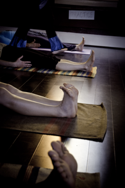
- Exhale press lower back toward floor as you lift your legs half way to vertical — 900 angle at the hip joint.
- Inhale continue lifting your hips up using the strength of your abs — Pay attention to NOT use your arms/shoulders to lift up — if you find yourself pressing your palms to the floor you are using your arms not your abs to lift.
- The bulk of your weight should be distributed across the shoulders. Pay attention to spread your body weight across your shoulders — and to not put weight on your 7th cervical vertebrae — the vertebrae that sticks out a little further than the others.
- Turn the palms of your hands upward, bend your elbows and place your hands behind your rib cage for support. In full shoulder stand, slowly work your hands toward your shoulder blades. If possible try to keep your elbows in line with your shoulders — try not to let your elbows flare as this puts some weight on the neck or spine.
- Slide your shoulder blades away from your neck. Keep your head and neck straight — do not look around or turn your head in this position.
- Chin position: Most people will feel better with their chin lifted — and this is the safer position. Some who hold tension in their neck and shoulders will feel better with their chin down and pressing more toward the sternum. This will create a deeper stretch on the back of the neck releasing tension. It will also cleanse the thyroid more than the first chin option.
- ½ shoulder stand option – Keeps you weight on your elbows, back, and shoulders — your hips are bent a little and your hands will stay closer to your hips (not your shoulder blades), your trunk is about at a 45o angle to the floor, there is more space between your chin and neck.
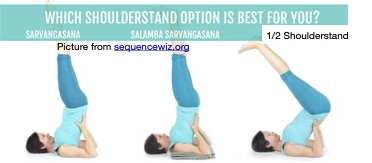
- ½ shoulder stand option – Keeps you weight on your elbows, back, and shoulders — your hips are bent a little and your hands will stay closer to your hips (not your shoulder blades), your trunk is about at a 45o angle to the floor, there is more space between your chin and neck.
- To continue up to full shoulder stand, inhale and reach your legs upward as you carefully slide your hands closer to your shoulder blades.
- Stay here for 10-25 deep slow breaths.
- To exit, exhale and bend at your hips moving your legs toward the next pose, plough or halasana.
Halasana
Hala in sanskrit means poison, so literally this is the pose that removes poisons from our body. 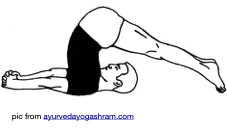
Removing poisons from the body and mind is what yoga likes to do. Does the phrase “samsara halahala mohasantyai” sound familiar? It should … It is in the opening chant or invocation of ashtanga yoga and literally means “eliminating the illusions caused by the poisonous herb of living: samsara (conditioned existence) halahala (poison) moha (delusion) santyai (peace).
- In other words just what we need to do to be alive causes poisons in the body and mind and we use yoga to remove the poisons of life.
Halasana helps us remove these poisons in our body in our yoga practice, and minding of your mindstuff will help to remove poisons from our thoughts.
Halasana is a combined forward bend and inversion and therefore the benefits of halasana are similar to sarvangasana, and forward bending. When we are forward bending our abdomen is pressing onto our thighs helping to circulate lymph and improve digestion, which also improves detoxification
- some of the same organs that help us digest such as the liver and pancreas also work to detox is, this is why if you have weak digestion you don’t detoxify well either.
By improving how we detox, we can also improve how we digest and better absorb the nutrients from the foods we eat. Yoga mala states this by saying halasana purifies the intestines
Further benefits touted in the book “Asana, Pranayama, Mudra, Bandha” by Bihar School of Yoga in India are similar to most forward bending postures and include: improves digestion, relieves digestive issues, cleanses spleen, and improves pancreatic, liver, and kidney functions.
Physically it can relieve back spasms, tones the spinal nerves improving the operation of our sympathetic nervous system. It also helps to balance the thyroid and stimulate our thymus boosting immunity.
This pose is contraindicated for anyone with spinal disc issues, sciatica, and neck issues, along with all the contraindications for inversion listed at the beginning of this section. Working personally with a qualified yoga teacher can help you learn how to do this pose safely if you have any of these conditions.
We continue onto to halasana from shoulder stand as follows:
- From shoulder stand, exhale and begin by bending at your hips and slowly
 moving hips away from your body lowering them toward the floor. To reduce the risk of back issues, keep your spine lifting and continue pulling your shoulders together to keep the neck off the floor. Lift the sitz bones and imagine that you are pulling your spine towards the front of your body as you slightly lift your chin. This will help create length in the spine and allow the breath to flow.
moving hips away from your body lowering them toward the floor. To reduce the risk of back issues, keep your spine lifting and continue pulling your shoulders together to keep the neck off the floor. Lift the sitz bones and imagine that you are pulling your spine towards the front of your body as you slightly lift your chin. This will help create length in the spine and allow the breath to flow. - You can remain with your feet off the floor, if you have flexibility and desire.
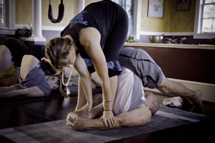 Exhale and lower your toe nails toward the floor, or just to a pike position until getting toes to floor is more comfortable. In the full pose done ashtanga way we put our toenails on the floor, slightly deepening the posture. If this is too tight on your breath, then keep the balls of your feet o
Exhale and lower your toe nails toward the floor, or just to a pike position until getting toes to floor is more comfortable. In the full pose done ashtanga way we put our toenails on the floor, slightly deepening the posture. If this is too tight on your breath, then keep the balls of your feet o
n the floor. - Another option if you have a wall, piece of furniture close by, or a prop is to put your feet flat on the wall behind you with your legs in pike position — 90o angle at the hip — or rest your feet on a chair or prop. This is a nice relaxing option in halasana and reduces pressure on the neck.
- Hands support the lower back if your feet are not on the floor. If your feet are on the floor, clasp your hands and straighten your arms along the floor.
- Stay here for 8-15 breaths
Karna Pidasana
Karna mean ear, and pida means pressure, so we are trying to put pressure on our ears.
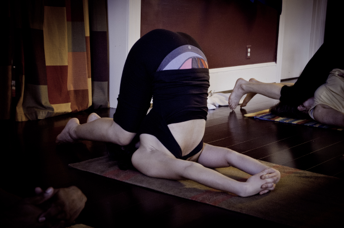 The benefits to karna pidasana start off similarly to sarvangasana and halasana, the pressure of squeezing your ears adds additional benefit to the ears. Yoga Mala and Light on Yoga say this pressure eliminates ear diseases and ringing of the ears.
The benefits to karna pidasana start off similarly to sarvangasana and halasana, the pressure of squeezing your ears adds additional benefit to the ears. Yoga Mala and Light on Yoga say this pressure eliminates ear diseases and ringing of the ears.
I could not find any data to back that up, but did come across some information through TCM (Traditional Chinese Medicine) and reflexology about squeezing and massaging the ears … and it is so inline with why we do some of the things we do …
According to TCM; there are points in the ears that stimulate certain parts of the brain and reduce sympathetic activation (again, working with our nervous systems to stay PNS dominant) and increase Parasympathetic activation — so basically keeping stress low so our body can heal and rejuvenate.
I also found some information through ear reflexology. They talk of pulling on your ear lobes to feel refreshed, massaging the entire ear for more energy, unrolling the outer part of your ear improves focus, massaging your ear lobes to relieve tension, and massaging your outer ear with your palms to relieve anxiety.
So there does seem to be sufficient data out there connected to massaging or stimulating the ear in some way. And it does feel good! I give myself ear massages a couple times each week and it always feels good. I also used to sometimes give ear massages when I did little “special treatments” while you are in rest pose and it always got a good response from the person receiving it!
To do karna pidasana and feel these benefits, we do karna pidasana after shoulder stand and halasana, so from halasana:
- From halasana, Exhale, and bend your knees toward your forehead, if you can go further you can squeeze your temples (which also feels good), if you have the flexibility, put your knees on the floor touching your ears — then gently squeeze your ears with your knees. A review of your options:
- Knees to forehead
- Knees squeezing your temples
- Knees squeezing your ears
- How hard to squeeze your ears? I like to quote David Swenson here “If you can hear me, you’re not squeezing enough”.
- Knees on the floor, squeezing your ears.
- Be careful to not force the knees down to the floor – too much pressure can strain the neck. Knees can squeeze the temples until you able to reach your ears.
- You can support the hips in the hands as in the previous postures or clasp your hands and straighten your arms along the floor.
- If your breath is blocked or restrained in this posture, lift your chin or move your torso away from your chin — moving your hips back a little to give more space between your chin and chest.
- Stay here for 8-15 breaths.
Urdhva Padmasana
Turning your lotus upside down … now the closing sequence of ashtanga yoga 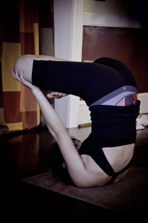 gets a little funky … these poses are also extending our time inverted.
gets a little funky … these poses are also extending our time inverted.
- From karna pidasana, place your hands on your back, straightening your legs, inhale and move your hips away from your head slightly keeping your feet together and
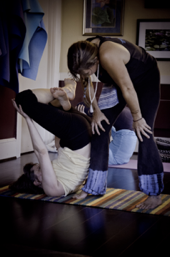 your legs straight in a pike position, then move your hips forward and go back up to shoulder stand.
your legs straight in a pike position, then move your hips forward and go back up to shoulder stand. - Exhale and if possible come into lotus using one hand to help tuck your feet in.
- If lotus is not happening for you, you can just cross your legs
- Or put the bottoms of your feet together as in baddha konasana style.
- Start with your hands on your lower back for support — if you can hold the position without your hands, then place your palms under your
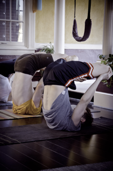
knees, straighten your arms – and try to balance on your shoulders. - My breath opens up and deepens in this posture 🙂
- Stay here for 8-15 breaths
This pose is said to open anal and urinary channels and relieve constipation —and indeed it does feel like it opens up channels in the the body as you move from karna pidasana where you are in a little ball to extending your spine (along with the next pose). It also strengthens our core.
Pindasana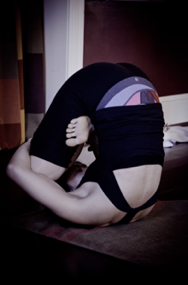
Pinda means embryo, you are making yourself tiny, like a little embryo.
- From Urdhva padmasana, hug your crossed or lotus-ed legs into your abdomen. Most people find balance easier here than in the previous posture.
- You can keep your hands on your lower back for support, or in the full posture, if you can balance, hug your legs in tight to your torso — and if possible clasp your hands together (clasping hands is optional — only if you can keep your fun breath).
- Or if you have a little tightness you can keep your hands on your lower back and lean your hips into your hands, and lean your feet or legs into your abdomen.

- Check your breathing? Do you have good breath? If not back out of the posture by moving your hips away from your head.
- Stay here for 8-15 breaths
In pindasana you are getting the benefits of forward bending in lotus positions (heels supporting our spleen and liver) along with the additional benefit of inverting — and as you squeeze your legs in with your heels in your abdomen you are literally “wringing yourself out” or wringing out our internal body — squeezing out toxins and stale blood improving circulation and nutrient and oxygen delivery to your cells. This movement is said to purify all the organs in the lower abdomen — the the liver, spleen, and stomach while it gives a good stretch to the spine.
Matsyasana
Matsy means fish, so this is fish pose.
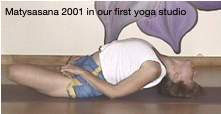
Now we counter pose the shoulder stand positions on the neck and spine that will help to remove tension or tightness that may have happened while we were in the shoulder stands. It is recommended to always follow shoulder stand with some version of a fish posture (there are many different ways to do matsyasana).
From Pindasana:
- Exhale and straighten your arms along the floor, palms down; Inhaling slowly uncurl your torso with your legs crossed or in lotus, keeping your head on the floor, and bring your back down to the floor.
- Keep your legs crossed or in full lotus.
- Place the area of your upper arm, just above your elbows on the floor; press your arms into the floor to arch your back and spine off the floor slightly, lift your chin and slide your head towards your hips putting the crown of your head on the floor.
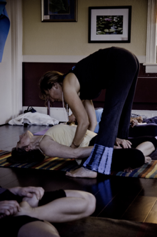
- If you are in lotus, catch your feet like a handlebar, expand and open your chest and front of your body and squeeze your shoulder blades in to cradle your heart. This action feels similar to a row.
- Do not keep elbows on the floor as this allows the chest to sink—grip feet or thighs and pull from your back muscles to lift and expand your chest and extend spine.
- Breathe big and deep! This pose stretches all the muscles of respiration and is lovely to get good breath in.
- Enjoy the breathing for 10-15 deep breaths.
In addition to what the yoga texts say about this pose, this pose is good for our rib cage mobility and breath. Our rib cages can become literally like a cage — squeezing our heart and lungs and not allowing them to function fully. Or our rib cage can be like an accordion and flexible gently massaging all our organs with each breath. This pose helps your rib cage be like an accordion.
- We have little muscles between our ribs called the intercostals. These muscles can become tight and stiff if we don’t ever take a deep breath. This pose helps to stretch the intercostals.
The pose encourages deep respiration and can help in cases of asthma and bronchitis. By engaging our back muscles in this pose it helps to circulate stagnant blood that may be stuck in the back of the body.
This pose is also an excellent counter pose to life itself! The head and neck position help to realign our neck and upper backs from hanging your head down all day looking at your cell phone …
This pose has a strong balancing effect on the thyroid as it brings fresh blood to the thyroid — and this pose stimulates the thymus as well, keeping our immune system balanced and functioning. Also the head position will give a nice stretch to the esophagus — a little flexibility in your esophagus can help prevent swallowing disorders.
Also the stretch of the lower abdomen is very good to helping to move matter through our intestines — in other words release constipation. It states in the ‘Asana, Pranayama, Mudra, and Bandha’ book that if you drink 3 glasses of water then do this pose it will remove constipation … I will have to try that the next time I am having that issue.
This pose does also give a nice stretch of the liver, stomach, and spleen area — an area that does not get stretched often (unless you do a lot of back bends). It can help the stomach relax away from the underside of the diaphragm reducing the risk of an hiatal hernia.
If you are able to do this pose in lotus, the pressure of your feet on your thighs reduces blood flow to the legs diverting it instead to the pelvic organs balancing the reproductive systems.
It is important to always follow shoulder stands with some kind of matsyasana style back bend.
There are two reason why this pose is called fish pose, the first being because the body and legs resemble that of a fish … the second reason is more fun;
This position is excellent for floating in the water! The position of the legs changes the centre of gravity which allows the face to stay just above the water where you can breathe — as the body stays compact it is able to float with less effort.
And it’s true! I have tested this — its just you have to be careful in the ocean because you can’t see where the tide is taking you — so don’t do it alone or do it in a pool or still lake or pond.
I get into lotus while in the water, grab my feet and arch my head back … and viola! I float an breathe … and the really cool thing … I can hear the whales sing while I am doing it 🙂 <3
Uttana Padasana
Extended or raised foot/leg pose
This second position adds strength to the abdominals. It is a mild back bend — not a deep back bend as some believe. Too deep of a back bend would mean you are not engaging your abdominals to support the pull of your legs therefore you end up hanging on your lower back muscles and tendons — not good. This is a strong asana.
From Matsyasana: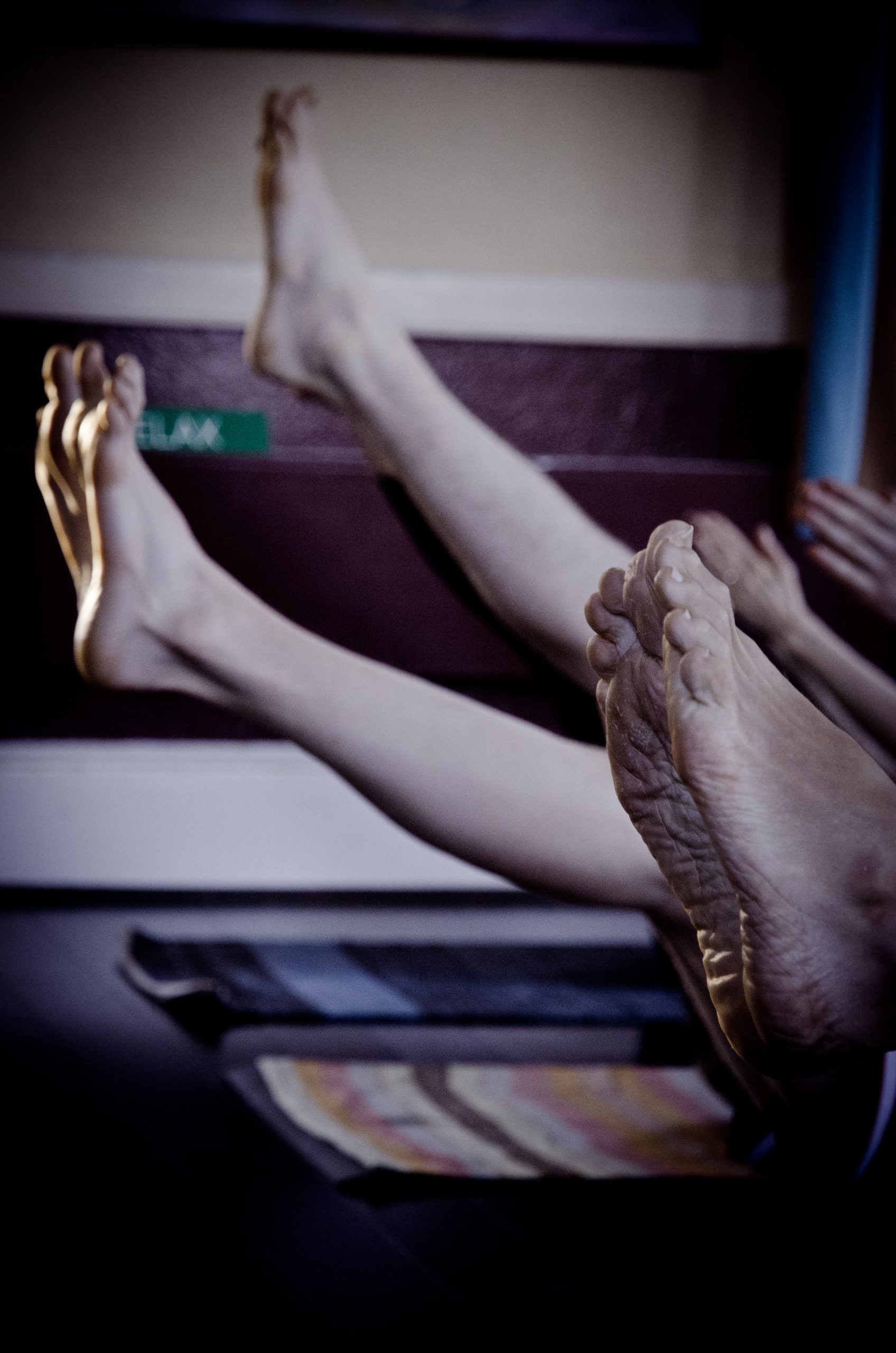
- Tuck the tailbone slightly — reducing the arch in your back — and tuck chin down slightly — engage your abdominals to support your back
- Inhale and extend the legs outward and off the floor (kind of like navasana or boat pose) so they are just above parallel to the floor
- In matsyasana we are arching the back in this pose we are starting to flatten out the arch in the back.
- Straighten your arms, palms together and hold your straightened arms out parallel with your legs.
- This should feel like an ab workout! This type of ab work, stabilization
is one of the best ways to strengthen our core. The main job of our abs is to stabilize and this asana helps to prepare the abs to do their job.
- If you can not engage your abs or this feels like too much work, bend your knees slightly and it will reduce the work load of your back and ab muscles.
- This should feel like an ab workout! This type of ab work, stabilization
- Breathe strong, take 5-10 breaths here — pay attention to not go beyond your strength which would leave the back open to strain.
- If you have back pain, diastasis recti, or any strain on the head or neck you can leave your legs on the floor while still arching your back off the floor.
- To exit, lift your head only (legs remain off the floor) tucking your chin down toward your chest, flip your hands around palms to the floor by your ears (like you are doing a back bend)
- With an inhale bring your legs up and exhale to bring them overhead to the floor behind you; do chakrasana (the backward roll) or rock and roll forward over your crossed legs and take a vinyasa.
Sirsasana
Sirsa means head, Headstand
Headstand … the King of asanas.
Headstand is best learned in person with a teacher — for safety reasons. I will give some explanations of the process for you to integrate; mostly my goal here is to touch on all the different opinions on how to do headstand, the controversies with each approach, and how to find your way through — or how to find your way of headstand.
Teaching yoga as my full time job for over 25 years now to thousands of bodies all over the world has been eye opening experience. You realize there is no one right way to do a pose — instead there is a right way for each individual to discover how to do the pose for them. That is my approach in teaching, helping you find your practice.
Headstand, while carrying many of the same benefits of the shoulderstands, also adds additional benefit. Especially to the pineal gland —if you remember at the beginning of this I spent some time educating about the pineal gland and its relevance in yoga. Not only does the pineal gland have the most profuse blood flow second only to the kidneys which headstand would support and improve — melatonin which our pineal gland secretes is what the yogis call our “Amrita Bindu” or the nectar of life.
It is also the pineal gland that is the seat of our “3rd Eye”. Our “third eye” is the eye of clairvoyance — or “clear vision” — that ability to sense something about a person, object, situation, or location through an extrasensory perception — or our 6th sense … which oddly corresponds with the 6th chakra.
Headstand does bring blood flow more efficiently to the pineal gland, 6th chakra/3rd eye, and to the eyes and brain in general.
The benefit of bringing blood flow to the eyes and brain, the yoga books say it will help prevent or heal eye diseases — and additional blood flow to the brain increases mental power and concentration, which is one of the reasons why we do not put body weight on the head.
It is important to NOT put weight on the head during sirsasan as this will impinge why we are inverting—to increase blood flow to the head—if weight is on the head then blood flow is occluded from the area instead of circulated through the area.
Before we get into the details, I’d like to review how to get out of headstand first, that is important as well.
Balasana – Child’s pose after headstand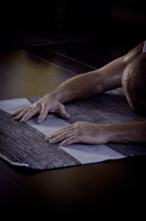
After headstand we drop into child’s pose without taking our head off the floor — and we keep our arms overhead, relaxed. From headstand position arms, as you move into child’s pose, relax your elbows a bit wider lying the underside of your forearms on the floor with your palms down and fingers touching. Your arms make like a circle around your head.
We do this to encourage blood flow around the heart. Yoga Mala and other yoga books say headstand purifies the heart due to increased blood flow. As we relax in child’s pose after headstand we are better able to circulate the blood removing the toxins that were dislodged from the practice — this is important — we want to get the toxins out and that is what i call “the other side of yoga”, detoxifying.
This rest in child’s pose after headstand is also better for your eyes — sometimes when someone gets up too quickly from headstand — or if they hold their breath in headstand — you get a blood shot eye. A tiny vessel in your eye can pop. While this is not harmful, it’s not something we want to create during headstand.
And one of my favorite upsides to learning how to balance upside down … Headstand is useful at developing our awareness of our center (of gravity) and balance — which will help in all other movements — including activities of daily living. It is a very empowering feeling. The inner awareness developed by headstand will carry over to other postures as well. Balancing upside down makes it easier to be balanced on your feet.
This inner awareness and balance which develops is important to keep honed in as we age. The risk of falling greatly reduces if you have a good center of balance while you are moving. Headstand helps us develop the awareness necessary for this important benefit.
Are you and apple or a pear?
It may make a difference on how easy headstand is for you.
Pear shaped people will have a harder time learning to find balance. Balance requires your center of gravity to be over your base of support — and the lower to the ground (base of support) your center of gravity (where your body is most dense or heavy) is, the easier balance is. Inverted apple types will have their center of gravity closer to the ground making balance easier.
Pear shaped people (center of gravity is lower toward the thighs) will have to work a little harder to find the sweet spot of balance. Further making inversions where you have to support your body weight even harder for most pear types — is most pear types tend to have petite upper bodies (lucky you!) while apple shaped people tend to carry a little more upper body muscles.
Don’t fret though if you are a pear … I have seen many pear shapes learn headstand solidly even with the additional challenge.
In headstand – Bandhas and Breath are very important
From Yoga Mala: In sirsasana’s state, both the lower abdomen and the anus should be taken in fully and held tightly — in other words mula bandha should be done. In addition, the entire body should be kept erect and exhales and inhales performed deeply without kumbhaka (breath holding).
The inverted position makes the bandhas easier as gravity is assisting. As I speak about often I tie my bandhas to my breath — each Inhale comes with a lift (anal squeeze) of mula bandha, and with each exhale your abs follow the exhaling breath up and under your rib cage — literally your abdominals are helping you exhale more fully — which in turn give you a better and deeper inhale.
While inverted breathe with bandhas 🙂
Also pay attention to not hold your breath — very important so not to build up too much internal pressure. And there should be NO pause between the inhale to the exhale — and from the exhale to the inhale. We practice what is called connected breathing where each half breath smoothly turns into the next.
And be careful to not put tension in your breath — our upper body is very active during headstand supporting our body weight, it can be easy to put tension in your face, jaw, lungs, and breath. Remember Free Breathing You Do!
How to not put weight on your head:
We must learn the art of supporting ourselves with confidence. The key is to build a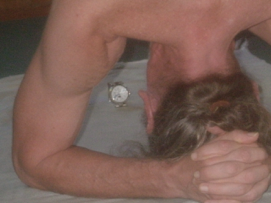 solid foundation and knowing how to find your balance point — or what some call the “sweet spot”.
solid foundation and knowing how to find your balance point — or what some call the “sweet spot”.
There is sweet spot or a zone of balance of least resistance meaning you are aligned so your muscles don’t have to work as hard to hold you there — however this spot is a bit scary as you can not control which way you would fall out of headstand — if you were to fall. More on falling in a bit.
There is a feeling of lightness and even a little exhilaration when you find your sweet spot or balance point.
That is because you have aligned yourself for leverage — your muscles do not have to work as hard to hold balance. Most beginners in headstand, or those fearful do not find that sweet spot and have to “hold” the balance with their muscles — which is easier for men to do. Women will not be able to hold headstand very long if you don’t find your sweet spot of perfect balance.
The balance point is when your hips are perfectly aligned over the center of your forearms, which is about where your shoulders are. If you think about posture standing — our shoulders are over our hips — to stand with your shoulders in front or behind your hips usually means pain is coming for your back or neck …
Most people will “emotionally” struggle with getting their hips into the sweet spot because it is scary. When someone is “muscling headstand” meaning using pure brut strength to stay there their hips and body weight is usually in their elbows. In this position you can control your “fall” and bring one leg down easily to catch yourself, which is emotionally comforting. When you are on your balance point, if you were to fall you would either have to catch yourself in a back bend or tumble out. I will review that shortly — it is important to learn that before you learn headstand. If you are not ready to find your sweet spot, that is ok, just remember it will be harder to keep weight off your head and therefore you will only hold headstand for a couple breaths. This will help give you the confidence over time to find your sweet spot. Then headstand becomes joyful.
Even though it is called headstand, it is truly an arm balance as you are not standing on your head — it is only lightly touching the floor.
Balance requires your center of gravity to be over your base of support. Let’s build our base of support.
Building the Foundation: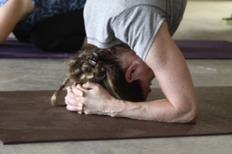
- From down dog and come to a kneeling position.
- Place your elbows on the floor about shoulders width apart, or slightly closer.
- The reason for this is because with your arms more parallel it gives you a longer base of support front to back, widening your balance zone — and it makes you more stable front to back. With your elbows wide you are more stable side to side. Most people in headstand don’t fall to the side — you fall forward or backward.
- There are some people who will need to take their elbows wider – if you have long arms this may be you. If that’s your case, it will be slightly harder to find balance as your base of support gets shorter. It may also be harder to keep the weight off your head, stay aware of that and come down if you feel weight on your head.
- Lace the fingers with the little finger side against the floor, ground your forearms and lift your pinkies off the floor.
Hand Position?
Here is another area of debate. Some are taught to interlace the fingers tightly, 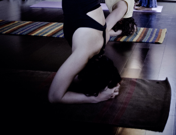 keeping your palms close together (and this is my preferred way).
keeping your palms close together (and this is my preferred way).
Others find letting their hands drop open and placing the their palms on the head more helpful. I do find it is easier to keep weight off my head with the first option, however many people have told me they can keep weight off their head with the second option as well. Choose which one feels best for you!
What part of your head to put on the floor? This varies from person to person! Please do not let someone tell you there is only one safe way.
Most people will find balance easier if they put the spot about an inch or so behind your hairline on the floor … unless your hairline is receding 😉 Did you ever play soccer? It is the part of your head that you head butt a soccer ball with because it is the hardest part of your head; it is the part of your head just above your forehead.
When you have this part of your head on the floor, you still have the natural S curve in your neck and spine. Tis is ideal as the S curves in the spine are what protect your spine like a spring — giving your spine buoyancy. If you were to flatten out the curves in your neck and spine your spine would lose some “spring”.
Also balance is easier with this part of your head on the floor. I also find the hand position of keeping the palms close is easier with this head position. I place my head so it is touching the base of my thumbs and the sides of my head are cradled by my arms. In this position I can easier keep weight off my head.
The other head option reduces the curvature of your neck and makes balance a little harder to find. It is putting the crown of your head toward the floor, which straightens out the neck and spine somewhat. The open palm hand position tends to be more popular with people who like this option better. Your open palms cradle the back of your head and help you support your body weight.
- Choose which part of your head you like on the floor — if you don’t know yet, then I advise to place the top of your head just behind your hair line on the floor keeping the natural curvature of your neck.
- Slide your shoulder blades toward your hips. This little movement is important and will strengthen one of your best posture muscles — your lower trapezius — which is responsible for keeping your shoulders away from your ears. In many people their lower trapezius is weak and over stretched while their upper trapezius is too tight and strong keeping their shoulder blades up too high and creating stiffness in the shoulders and upper back / neck area.
Straighten your legs if you have the flexibility, walk the feet toward your elbows a little, lifting your hips up and over your shoulders. If you have tight hamstrings you will have to bend your knees to get your hips over your shoulders as they will be when your feet are off the ground to have balance.
In this position you are kind of in a down dog position with your head and arms on the floor.
Slide your shoulder blades toward your hips and broaden your collarbones. If you have never done headstand before you can stay in this position for breaths and still receive benefits from being inverted. This position will also strengthen you to support your headstand more safely one you are able to float your legs.
Learn how to fall before you learn how to fly
This is important — no matter how good you are at headstand … one day you will have an off day or be distracted and fall out of headstand. You want to safely know how to fall.
About using a wall ~ if you are by yourself you do need a wall close by to keep you from falling until you know how to fall safely. However, word of caution, do not become reliant on the wall or stay up in headstand leaning against the wall. It will make it much harder to ever find balance because leaning against a wall in headstand is training your body to not do what it needs to do to find balance. Just use the wall to tap your foot on to keep from falling while you try to find balance. If you can’t stay up at all without leaning on the wall, then try to find balance and if you don’t come back to down dog/headstand position.
How to fall
Once you are confident you know how to catch yourself falling out of headstand you will get headstand! You will be able to “work it” until you get it safely.
Falling out of headstand refers to falling over backward or sideways. Falling sideways most people are able to get a foot down on the floor and catch themselves it’s falling backwards I want you to feel confident about.
There are two ways to fall over backwards, tumble or land in a backbend. It is safer to land in a backbend IF you have the back bending flexibility to do so with your forearms on the floor — its a deeper back bend than even urdhva dhanurasana (wheel pose) and requires shoulder flexibility.
To facilitate falling into a back bend, its easier to have the head position where you keep the curvature of your neck — the neck position makes it easier to get into a back bend because your back arches better if your neck is arched too. Try it in your other back bends such as ustrasana or urdhva dhanurasana and feel the difference.
The first few times you try dropping into a backbend, do it with a teacher present who can help you land it if your shoulders are too tight to allow you a deep enough backbend.
If you have good back bends — while in headstand :
- lift your chin away from your chest
- arch your back – reaching your feet for the floor — if you can balance there pause
- Then just drop your feet down.
Practice it if you can do it safely — as when you fall for real you might not have time to think about what you need to do to land on your feet — you want to instinctually know.
Tumbling is a bit harder and can sprain your ring finger if you are wearing a ring, and you don’t release your hands in time — so might be a good idea to take off rings when learning this. it is important to know how to roll out if you can not drop in a back bend.
So rolling out is easier with the second head position — crown of your head on the floor and the open palm hand position since we will be doing that to tumble anyway. To tumble out:
- open up palms and move backs of you hands toward the floor
- Tuck your chin towards your chest — which will facilitate the tumble
- Tuck your knees toward your chest and roll over your hands.
I recommend this to be done for the first time with a teacher present who knows how to spot this — a teacher can slow your fall so you can feel what to do until it becomes instinctual.
The feet begin their journey toward the sky.
- To lift the feet from the floor it will be necessary to transfer your weight behind you. This will create a momentary unbalancing – this is what will draw the
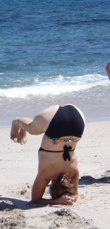 feet upward. I call this falling up into headstand 🙂
feet upward. I call this falling up into headstand 🙂 - The trick to keeping balance is to bring the hips back to the center line as the feet rise above parallel, otherwise the weight which is floating your legs upward will become the weight that will cause the entire body to fall over backwards.
- It is a matter of getting used to being upside down and feeling the transfer of weight. As you begin to move your hips back, feel the weight moving from your feet into your arms, bend your knees to allow the feet to rise. It is your hips that are raising your feet.
- If you can get your feet off the floor with your knees bent and feet close to your buttocks — you can stay here and take your headstand breaths here until going further becomes comfortable.
- As you gain control you may begin to straighten the legs.
- Spread the weight evenly across the elbows and forearms, keep your pinkies slightly lifted off the floor.
- As you get your feet up off the floor — if you are keeping your legs straight or knees only slightly bent and kind of piking up then, after your feet pass parallel your hips move forward again and back in line with your shoulders. And there you are in headstand 🙂
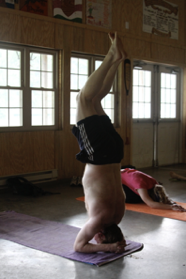 NO WEIGHT ON HEAD
NO WEIGHT ON HEAD
-
- Pull legs together and point your toes
- Hold position for 10-25 breaths — Remember your bandhas – they will help with balance. When I see someone’s belly hanging out and they are trying to get up in headstand, I
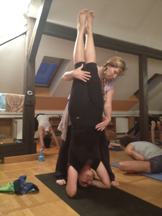 gently tap the uddiyana bandha to remind them and it instantly gives them better balance.
gently tap the uddiyana bandha to remind them and it instantly gives them better balance.
Finding your alignment upside down
This made be tricky for some, most people arch their back in headstand and make a banana type of shape. And balance is easier this way, so for some people if that does not cause pain and they feel good with it, it is a temporary alignment as you develop your senses upside down. Tips to helpng you find your alignment upside down:
-
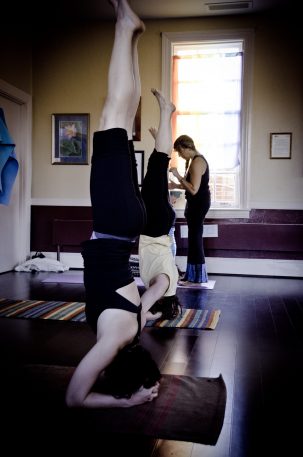
Photos by Cathrin Queins
Engaging your uddiyana bandha will help you remove the arch from your back and pull your body into better alignment. Try to feel if you have an arch in your back — if so can you lengthen your lower back? The back of your head, trunk, and back of your thighs, and heels should be relatively in line — the same with the front of you body; the throat, chin, and breast bone. - Remember to keep your shoulders away from your ears — slide your shoulder blades toward your hips.
- Is one side of your waist shorter than the other? This does happen frequently which will have you leaning to one side. See if you can get both sides of your waist long and even.
- Do you feel more weight on one forearm than the other? You might be leaning slightly into your strong side, see if you can balance your weight evenly on both forearms.
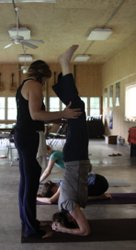
To Descend: to descend smoothly it again requires you first move your hips just as we did to go up. With an exhale you slightly bend at your hips moving toward a pike position — but with bent knees until you have the balance and flexibility to pike down with straight legs.
- If I was assisting you, I would place my fingertips gently on the front crease of
you hips and gently move your hips toward me.
If you don’t begin the descent by moving your hips your feet will crash to the floor.
Continue to bend at the hips, and for now, bend your knees and bring your legs closer to you chest, as your toes get closer to the floor you can begin to move your hips forward again.
Once your feet touch down, open your hands and relax into child’s pose with your arms overhead forming a relaxed circle around you.

-
- Rest in childs pose 5-10 breaths as explained above. This is important after headstand to redistribute circulation.
What about the half bend aka urdhva dandasana? Traditionally in ashtanga you come into a half bend, hold that for 3-5 breaths, then go back up to headstand for one breath and slowly pike down. This is a bit advanced, and may put weight on the head for some people, for those interested I prefer to teach that in person on an individual basis.
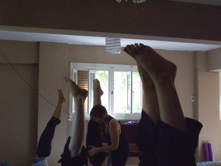 Whew, this wraps up inversions. One of my biggest topics! I hope you found it helpful.
Whew, this wraps up inversions. One of my biggest topics! I hope you found it helpful.
